




scale with a larger customer base.

High local manufacturing costs may discourage substantial investments in production facilities and equipment. Importing helps mitigate risks associated with significant capital outlay, allowing businesses to allocate resources to other critical areas like marketing, distribution, and customer service, enhancing overall efficiency and competitiveness.



The Food and Grocery Council is an industry association for grocery suppliers providing members networking, events, industry information and strong advocacy. Contact us for information on the benefits of membership: raewyn.bleakley@fgc.org.nz







• Networking • Industry Updates
• Conference and Events
• Education and Training
• Advocacy and Law Reform
In New Zealand’s current business landscape, high local manufacturing costs pose challenges for domestic businesses. However, this situation also creates opportunities for imported products to meet consumer demands. By exploring global markets and leveraging cost advantages, imported goods contribute to New Zealand’s economy. After a hiatus during COVID-19, food and beverage exhibitions worldwide are flourishing, with record attendance levels from various countries as attendees look for products to import. The networking opportunities, trend reports, new products and innovation coming through at these events are back as a must-visit.
The competitiveness of imported products is key to their success in our local market. Importing

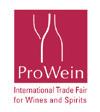



from countries with lower manufacturing costs allows businesses to offer competitive prices, attracting priceconscious consumers. Imported products can also bring variety and innovation to the local market. Local manufacturers may have limitations in resources, technology, and expertise, hindering their ability to offer diverse products, or they may be hindered by being too small to compete when ranging in store is constrained.
Importing goods provides access to a wide range of options, including innovative and specialised products not available locally, expanding consumer choice and promoting market dynamism. Importing also grants businesses global market access. International suppliers have established distribution networks and economies of
Balancing support for local industries and capitalising on global opportunities is crucial for New Zealand’s economy. Local manufacturing contributes to job creation, economic growth, and selfsufficiency, and we need a collaborative approach that combines the strengths of both local and imported goods. A balancing act that needs experience at the helm.
www.fgc.org.nz
The NEW ZEALAND BEVERAGE COUNCIL is an industry association whose members cover all aspects of the non-alcoholic beverage market both in New Zealand and the export markets.



The Council members are spread throughout New Zealand and come together annually for a conference that covers industry issues and is addressed by international speakers. The organisation monitors product quality, sets standards for the industry and runs national competitions and awards.
PUBLISHER Tania Walters
GENERAL MANAGER Kieran Mitchell
EDITORIAL DIRECTOR Sarah Mitchell
EDITOR Caitlan Mitchell
EDITORIAL ASSOCIATE Annabel Maasdam, Sam Francks SENIOR DESIGNER Raymund Sarmiento
SENIOR DESIGNER Raymund Sarmiento

BusinessNZ has said that the Government’s Budget announcement provides a well-being boost for some, but is light on business investment.

Chief Executive Kirk Hope said most benefits for business are fringe in nature.
“Reduced public transport costs, scrapped prescription fees and increased ECE entitlements may have a benefit for some business owners and employees, but if we want real growth-promoting policy,
businesses will need more direct investment than that,” said Hope.
Hope said some positives from the announcement include investment in the gaming industry.
“Further investment in cyclone recovery and education are essential and welcome to get New Zealand back on track. Businesses were also hoping to see investment in infrastructure and immigration to assist in increasing productivity.” Read more here
Award-winning local brewers RedDot BrewHouse, Brewlander, Sunbird Brewing Company and Lion Brewery Co are among the headlining brands of Singapore-made craft beers at Beerfest Asia 2023, taking place from 22 to 25 June on new festival grounds at the Kallang Outdoor Arena, the open carpark space outside Leisure Park Kallang.
With over 600 varieties of beer from around the world, the 13th edition of Beerfest Asia will feature the most extensive line-up of exhibitors ever at the event, with over 100 booths offering top-selling brews, fresh new flavours and a unique curation of gourmet food over four days for beer

Foodstuffs North Island Merchandise Manager of Produce Brigit Corson, with Primor Head of Domestic Avocado Sales Regan Booth, explained what had happened to New Zealand Avocados.
As a favourite toast topper for Kiwis, many have noticed Avocados have become scarce from supermarket shelves lately. Foodstuffs North Island’s Produce Merchandise Manager Brigit Corson revealed a few things at play.

“The main reason we’re seeing fewer Avocados on supermarket shelves is because the Avocado season has run short,” Corson shared.
enthusiasts and festival-goers.
Highlights include top-rated Australian craft breweries Range, Mountain Culture, One Drop and Deeds, Vault City from Scotland, Sudden Death from Germany, Overtone, Tartarus and North Brewing from the United Kingdom, Jing A from Beijing and Young Master Ale from Hong Kong. Beerfest Asia also welcomes local breweries joining the festival for the first time, such as Rye and Pint, Ollie Hard Seltzer and Alive Brewing.
Attendees can expect a buzzing entertainment line-up with over 30 musical acts across four days.

Read more here
Primor’s Head of Domestic Avocado Sales Regan Booth, who supplies most of the Avocados for Foodstuffs North Island’s PAK’nSAVE, New World and Four Square supermarkets, added that New Zealand was currently sitting between two seasons.
“This hasn’t happened for a few years now. Normally we have our old season and our new season mash together, so we don’t run out of product, but this year it just hasn’t worked out,” said Booth.
Read more here










Foodstuffs North Island is pleased to announce the opening of the brand-new Four-Square Te Kowhai in rural Waikato. Featuring the latest designs and innovations, the store is operated by first-time owners Satnam and Randeep Kang. Designed to meet the needs of the Te Kowhai community, there’s a focus on convenience and ease with the new store offering a wide range of essentials, fresh foods, and self-checkouts, along with a great range of convenient meal solutions.
Read more here
The 2023 Grocery Charity ball has been announced, with tickets for the premier event now on sale. The event is one for the social calendar for all those in the grocery industry. Set to be held on the 14th of October 2023 at the Great Room in the Cordis, Auckland, the event has a black tie dress code.


Read more here
Economic activity remained finely balanced at the start of 2023, with a strong labour market, rising interest rates, and weather disruptions all significant influences on a cautious but still robust start to 2023. Infometrics’ March 2023 Quarterly Economic Monitor showed a 2.7 percent per annum rise in provisional economic activity in the March 2023 quarter, although several indicators signalled a more challenging economic outlook.
Read more here

As an established brand of paper towels, Tuffy recently saw an opportunity to energise sales by refreshing its branding and packaging.



the value of standing out,” said Grantham.
“One of the keys to that is packaging and, even with well-known and successful products, a packaging refresh can get immediate results- as well as long-lasting ones.”
Onfire moved away from the previous masculine look and aimed to appeal to a broader audience. Built around the line ‘Mess Happens. Get Tuff.’ the packaging was modernised with fun and colour not usually associated with paper towels.
In a generic and highly commoditised category at the Point of Sale, Onfire Design was tasked with giving Tuffy a modern edge to make it stand out from the competitors.
Led by Creative Director Matt
Grantham, Onfire challenged its client, Cottonsoft, to take a less conservative approach, reflect more contemporary values and capitalise on the value of the brand name ‘Tuffy.’

“Experienced brand owners that compete in crowded markets understand




As a result, new life has been breathed into the mature brand, and Tuffy has regained real presence on the shelf.

To complement the new packaging, Onfire has also developed a communication strategy for a national campaign featuring a new TV spot.

“We take all the values and features that make up an identity and translate

them into visual elements that customers love. It’s more than packaging. It’s all about communication and story-telling that can carry across any media,” shared founder Sam Allan.
To ignite your brand, get in touch with Sam and Onfire Design at 09 480 2036 or 021 608 204.
www.weareonfire.co.nz n
“It’s a region with some dynamic economies and powerful consumers, yet communities live under poverty and are the frontline of climate change impact. It’s a privilege for me to lead this movement designed to work at the intersection of such forces,” said Nathan.
Nathan worked with Fairtrade in India between 2015 to 2017, after which he worked with not-for-profits before returning to Fairtrade as CEO. Nathan revealed that working with the organisation had felt like a homecoming, as Fairtrade was the organisation where he began his career in the development sector.
Senthil Nathan CEO, FAIRTRADEThe new CEO of Fairtrade, Senthil Nathan, is excited about his new position, sharing that the idea of Fairtrade is well known now, more than ever, specifically in Oceania.

Having worked closely with smallholder communities in most of Asia and Oceania, across these countries, and as varied as they are, Nathan said that the aspirations of each smallholder community were the same.
“They need fair prices which will help them to lead a dignified life, improve their farming practices, and provide necessities for their families.”
When sharing why fair trade was important to him, Nathan said that when consumers walk into a supermarket and choose a product, they choose between paying the lowest price or choosing sustainable products. Nathan gave the example of whether a consumer should choose a product that alleges its sustainability or a product certified as fair trade.

“Fairtrade remains the best option by far. When a consumer buys a product with the Fairtrade mark, the value directly flows through to the producer communities as Minimum Price and Fairtrade Premium.”
When consumers choose a Fairtrade product, the choice compounds and has the power to transform the world. Furthermore, the Fairtrade mark is the world’s most ethical label.
Nathan elaborated Fairtrade’s practices are outlined by three key features, Fairtrade Minimum Price, Fairtrade Premium, Fairtrade Standards, and Ownership by Producers. Fairtrade Minimum Price for all commodities acts as a safety net for farmers and workers, protecting them from market fluctuations and helping them plan for the future. Secondly, Fairtrade Premium is an extra sum paid to a community fund where the product is produced. Then the community democratically decides how to spend it based on their environmental, social and economic needs.
Nathan commented that this funding could be for anything from health centres to new farming equipment and solar panels for electricity.
Thirdly, Fairtrade Standards, wherein producers and traders must meet standards or rules about conducting their business to be considered fair trade. This encapsulates environmental protection, fair pay, and gender equity.


To monitor these standards, an independent body conducts audits to make sure that the Standards are being met.
Finally, Ownership by Producers is a method of conducting business where Fairtrade is the only certification system co-owned by the producers, who have 50 percent of the votes in the organisation’s decision-making. Therefore, producers have the opportunity to help shape the Fairtrade Standards and prices so that they genuinely benefit.
Consumers globally have become more focused on the impacts of their purchasing decisions, with a global study revealing that 94 percent of those surveyed wanted to live a more sustainable life. In New Zealand specifically, research conducted through Kantar revealed that from 2000 New Zealanders surveyed, 90 percent were committed to taking action to live a more sustainable lifestyle, which has increased by 9 percent in 12 months.
Furthermore, Fairtrade is one of the most recognised ethical labels in New Zealand, with 55 percent of New Zealanders surveyed stating that they knew buying fair trade products was essential.

Consumers and businesses have grown more knowledgeable about the impact of Fairtrade, with ethical sourcing transitioning from a ‘fringe’ issue to a part of the mainstream. Nathan explained that this growing awareness and understanding has meant that ethical sourcing has become a manner of making good business decisions.
Nathan shared that Fairtrade has remained driven by addressing the inequities of the trading system. He offered the example of cocoa farmers worldwide, with approximately five to six million global cocoa farmers who possess mostly small farms in areas such as Cote d’Ivoire and Ghana, where 70 percent of the world’s cocoa is produced. The cocoa industry is dominated by nine global companies, from trading to processing and manufacturing.
“For every tonne of cocoa sold, farmers are estimated to receive less than 7 percent of the value of the final product, whereas
the manufacturers get 35 percent and the retailers get 44 percent. Pushing cocoa farmers into poverty and causing issues like child labour.”
By comparison, Fairtrade cocoa farmers are part of a cooperative or group to become Fairtrade certified, after which they have access to a market where they are paid a guaranteed minimum price for their cocoa, with their communities receiving an extra premium to spend on environmental, social and economic issues that they are facing.
“We also support them to address issues like gender equity and child labour. It’s not a perfect system, but it goes some way to redressing the balance.”

Nathan hopes that there will be more awareness around Fairtrade and that consumers and businesses will recognise Fairtrade certification as the gold standard.
However, consumers are increasingly demanding more regarding ethical practices from businesses, supported by their willingness to pay a premium for ‘green’ products. While businesses have begun moving towards sustainable business practices, Nathan warned temptation to cut corners where consumers couldn’t see was still present in some companies.



























He emphasised the importance for the industry to maintain vigilance in ethical and sustainable practices being based in fact to avoid issues such as greenwashing.
When describing Fairtrade’s manufacturing processes and products, Nathan said that the organisation audits each of its products against its Fairtrade Standards, which means that with every purchase of Fairtrade coffee, for example, consumers can be confident in the knowledge that the farmer was paid






fairly, as well as the exporter, packers, and roasters. Achieving these assurances through the organisation’s globally recognised certification.






As the new CEO, Nathan focuses on building a better platform of understanding between consumers and businesses about the connection between paying people fairly for their work and sustainability. He explained that ensuring farmers can feed their families will ensure that they can take care of the environment through their farming practices, thus guaranteeing sustainability throughout the lifecycle of every product produced while also caring for the communities which farm some of the most significant ingredients in the market. n


time talking to counterparts around the world, particularly the Australian Food and Grocery Council, on how to achieve the best outcomes from the opportunities NZFGC has fought hard to achieve over the past decade. It became clear building a suite of support activities for members to equip them for operating under a Code would be critical, hence our partnership with NextGen and Matthews Law.
Sustainability remains another priority, and NZFGC has two important roles assigned by the Government in this area. First, as the co-design partner with The Packaging Forum of the Plastic Packaging Product Stewardship Scheme, and secondly in implementing the Australasian Recycling Label into New Zealand. These, along with other workstreams of our Sustainability Committee, enable us to be a key influencer and active player in what the future will look like.
The New Zealand food and grocery sector is in great shape, if the May Member Meeting and Annual General Meeting of the New Zealand Food and Grocery Council is any indication.

The around 200 delegates who attended not only heard some great speakers but also took full advantage of the opportunity to do some valuable networking that helps the sector perform well, stay connected and in good heart. It was fantastic to get a whole mix of people from across the sector –including, producers, manufacturers, supply chain experts, market analysts, salespeople, merchandisers, business advisers, food and legal experts, and recruitment specialists –in the same room chatting in an informal situation. It was hard to pull people away
from their conversations to be seated for the formal proceedings.
This was my first annual general meeting, and it was as fast-paced, interesting, and productive as has each of my first seven months as Chief Executive.
Having the Minister of Commerce, Dr Duncan Webb, update members on the legislation that will bring into being the Grocery Commissioner and the Grocery Supply Code was a coup. He was the first current Minister we have had at our AGM, and his update and clarification on the Government’s thinking on the Grocery Industry Competition Bill was invaluable.
Hearing also from NextGen, NZFGC’s partner along with Matthews Law on negotiating and informing members on the Code, would have assured members they will be in expert hands when that comes into being.
I told delegates in my annual report that getting out and about to meet as many of them as quickly as I could and building relationships with key government officials was my primary focus for my first year. Interacting with members and visiting their operations increases my understanding of the industry and the challenges members face in running their businesses, and I admit I thoroughly enjoy seeing their expertise and passion. I appreciate members being candid, and value the experiences and perspectives they share. These visits have been helpful to inform me about where to prioritise my efforts and what the work programme should look like.
The reform of the grocery industry to address the issues arising from a lack of competition as identified in the Commerce Commission’s Grocery Market Study in 2022 has been a big focus for NZFGC.
In preparation for the Code, I spent
NZFGC played a key role articulating the challenges members experienced as a result of the carbon dioxide shortage caused by the unplanned shutdown of the Kapuni plant due to health and safety concerns.
Significantly more impactful was the devastation caused by the three weather events in January and February. Though they were most significant for primary producers, some of our members experienced disruptions, and we’re all aware of their impact on food prices.
Unfortunately, such increases look like being an ongoing issue well into the current year, and even beyond, and this was something our Chair, Mike Pretty, of Heinz Wattie’s, mentioned in his annual report.
He pointed out that attempts by some to paint the big increases in food and grocery prices as solely down to suppliers showed those people did not – or deliberately chose not to – understand the many underlying issues involved.
He said that for a long time following the end of lockdowns, suppliers did a fantastic job of absorbing the cost increases, but they can do that for only so long – and that’s also true for unexpected events such unplanned outages and weather events.
Staff issues and cost pressures will most likely to be with us for some time to come, making it harder to manage and deliver affordable pricing.
But after talking to many members and visiting their operations you can rest assured suppliers are very aware of what’s going on and are working very hard to find efficiencies and hold price increases in a tough environment.
I look forward to working with the Board, which has some new members as a result of the elections at the AGM, over the coming year to support and be the voice of the members of the NZFGC in what will be a dynamic year ahead. n














































With growing consciousness for food choices, consumers have also begun to reevaluate their drinking habits and the impacts of alcohol consumption on their health and well-being.
This growth in awareness and concern for personal health has driven market opportunity for non-alcoholic beverages that taste like and look like traditional alcoholic beverages. New Zealand’s social culture is underpinned by alcoholic consumption, with after-work drinks, a glass of wine with dinner, or a Sunday barbeque with beer being common occurrences.
However, with consumer behaviour transitioning to healthier lifestyles, supported by healthy food and beverage consumption, the demand for nonalcoholic alternatives has increased, allowing consumers to comfortably enjoy their favourite alcoholic beverages minus the alcohol without judgement or removing the sociability associated with drinking.
According to FMI, the non-alcoholic beer market is estimated to reach a value of USD 21.345 million in 2023, which is anticipated to increase to USD 45.0195 million by 2033 at a compound annual growth rate (CAGR) of eight percent.
Non-alcoholic beers can lower blood pressure, inflammation, and homocysteine levels. Hop beers, in particular, boost the action of the neurotransmitter gammaaminobutyric acid (GABA), which is a fundamental mechanism behind sleep. When GABA levels rise, neuronal activity decreases, resulting in a calming effect in the brain.
This positive effect on the well-being of
individuals, both physically and mentally, has further driven the non-alcoholic beer market.
In the United States, non-alcoholic beer accounted for 31.2 percent of the global market share in 2022. Comparatively, China is expected to command a significant proportion of the market share over the next decade. The accessibility of various flavours and low-alcohol content beers across supermarkets and online channels in China is anticipated to drive sales at an 8.3 percent CAGR over the forecast period.
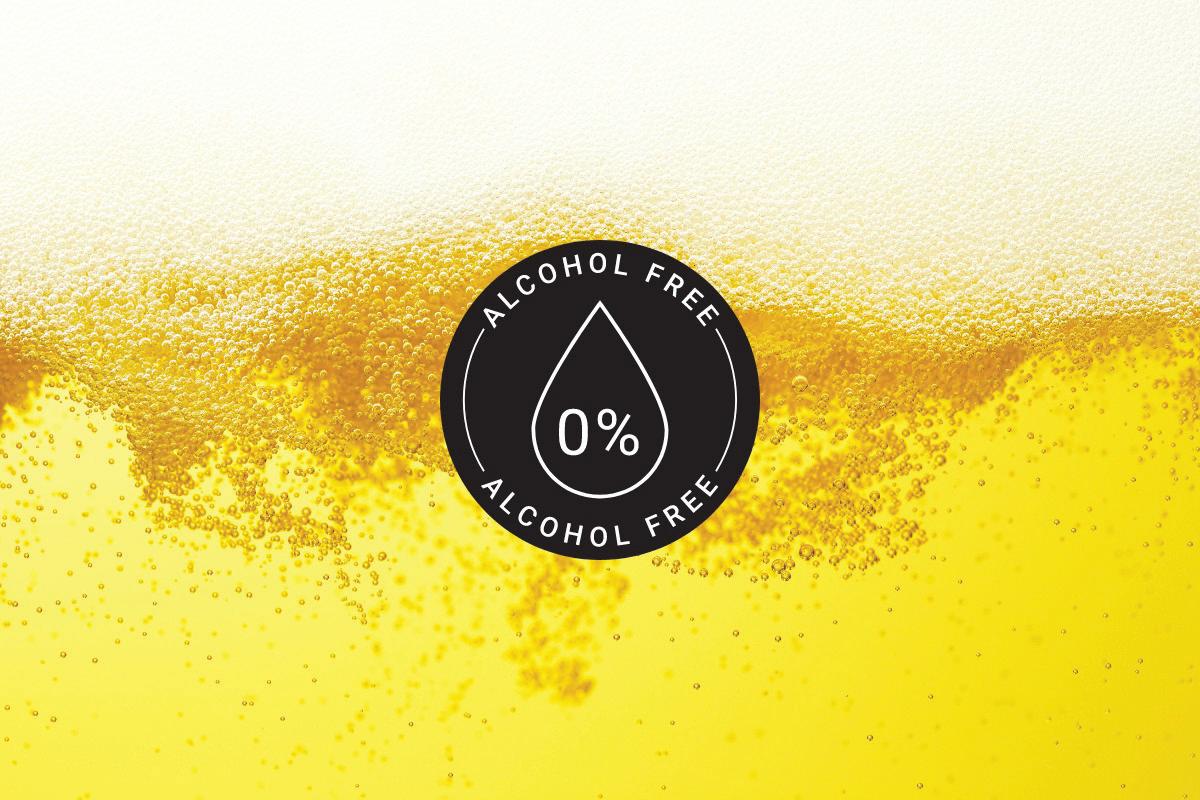
Data has also revealed that in New Zealand, 2.1 million consumers are either open to or have bought non-alcoholic beverages in the three months leading up to January 2023, a category increase of 40 percent since February 2022.
This change is being led by younger generations, with Generation Z consuming up to 20 percent less alcoholic beverages than millennials, as the perception of alcohol for younger generations, regarding its impact on mental and physical welfare, differs from the socialisation aspect it is often associated with.
With this generational change in the perception of alcohol and the growing consciousness of consumers making food and beverage decisions based on health benefits, the market for non-alcoholic beverages will experience significant growth and innovation opportunity. n
0%* alcohol. 100% flavour.


Founder and director of Finery, Jane Allan, shared that she was a mother of two boys, aged 11 and 8 years old and had a background in management across development and construction, mainly regarding financial and project management.
 Jane Allan Founder & Director, Finery
Jane Allan Founder & Director, Finery
panning back 20 odd years, a male-dominated industry with a heavy drinking culture. In the late ‘90s, I worked two jobs, by day in a developer’s office and by night at local bars and nightclubs,” said Allan.
In 2018, Allan’s sons were six and three, and while working full-time on high-end renovation projects, she had also taken on a training programme for a leaner, healthier lifestyle and body. As part of her training programme, Allan reduced her alcohol consumption to one alcoholic beverage per week.
After two weeks of no alcohol consumption and eating a raw, wholefood diet, Allan noticed a remarkable improvement in her mental and physical health. This led her to reevaluate her diet and lifestyle regarding beverages to improve her overall health.
Allan commented that Australia and New Zealand have a socially dominant drinking culture. When she wanted to maintain the sociability of going out with friends, Allan wanted not to be judged while having a drink minus the calories with little to no alcohol.
“Nothing on the menus told me ‘it’s ok you’re not drinking’. Everything was childlike or full of sugar.”
For Finery, creating a beverage for New Zealanders that affirmed that it was okay to drink or not drink alcohol was the primary goal. Secondly, it was for the beverages to look and taste the same, to remove the

question of why someone was not drinking. Furthermore, normalising ‘mixing it up’ underpinned Finery’s goals for future generations as the business aims to change New Zealand’s established drinking culture. Allan hopes that by the time her sons reach an appropriate drinking age, Finery has addressed New Zealand’s drinking culture and made a positive change towards helping New Zealanders build healthier relationships with alcohol, removing the binge drinking culture that has been prevalent since the ‘80s. By 2030 Finery, as part of the broader zero categories, intends to have reshaped New Zealand’s drinking culture by ensuring that better-for-you low and no-alcohol beverages are accessible and affordable throughout New Zealand.
Allan described the demand for the zeropercent beverage market as a reflection of consumers prioritising their health and wellbeing, elaborating that the pandemic was a turning point for many as time was allowed to slow down and New Zealanders were able to assess what habits they had in their personal and working lives that they did or did not like.
Over-consuming has become a common phrase for consumers who have reflected on incorporating zero-percent beverages into their weekly routines.
Allan noted that consumers are inclined to mixing their favourite everyday beverages with an in-between option, choosing lower calorie and carbohydrate options of their favourite flavours. Secondly, Allan shared



arage Project has introduced its Tiny Hazy IPA and Tiny XPA. The range is specially fermented, giving the juicy hop character and tropical aromatics Garage Project is renowned for, all without the alcohol. Full of big flavour without booze, these tiny but mighty beverages can be enjoyed anytime.


that consumers still enjoyed drinking. However, the push for zero-percent resulted from the desire to half alcohol consumption, with some choosing to leave drinking for special occasions only.
Growth within the better-for-you market centres on creating availability and accessibility to support consumers wanting to make healthier choices. This includes ensuring there are limited options with preservatives and artificial ingredients, which, if they are present, Allan advised should be clearly labelled to help consumers discern between their options.
“There is certainly room in this space for quality sparkling wine varietals, great tasting beer options and creative adult ready-todrink options.”

Allan revealed that Finery had exciting innovations and longer-term projects underway that have presented the company with opportunities to develop new beverage ranges using local ingredients ready for Spring to support consumers looking to moderate and choose a healthier alternative for their health and the environment.
However, the most significant challenges the zero beverage industry faces moving forward is shelf space and location in supermarkets. Allan shared that zero beverages needed to be in the correct location to help consumers buy fewer alcoholic beverages in favour of zero drinks. Therefore visibility and location are critical for consumers to avoid missing buying opportunities.
Furthermore, Allan shared that with the category’s growth, new brand offerings will enter the zero beverage space, making product development and innovation important to maintain a point of difference to avoid having copies of the same flavour or beverage with a price war between manufacturers.
Thirdly, Allan stated that working closely with category managers to inform them of new developments and innovations in the zero beverage space was vital in helping the category’s growth and giving consumers access to the best options.
Finery prides itself on its unique flavour combinations that are light and refreshing,

designed to be consumed daily as individuals would enjoy a glass of wine with dinner. The range has been crafted to replicate the brand’s low-alcohol recipe from 2019 from a seven-times distilled white spirit, with its overarching goal being to present consumers with a choice to drink or not drink alcohol without judgement.
“Our drinks look the same and taste the same with or without alcohol, leaving the social validation out of the question.”

Each Finery drink is crafted with health and well-being at the forefront, with little to no sugar, and no preservatives or sweeteners, using locally sourced ingredients where possible whilst maintaining flavour and affordable price points.
The packaging is light, recyclable and 100 percent home-compostable.
Allan’s personal favourite Finery beverage is the Giner Green Tea, Honey Mint and Lemon in either the zero or five percent.
“Is so mouthy, and we have just reformulated the recipe to give that extra Ginger spiciness. I love this tipped-over ice on its own or with a slice of lemon.” n
Founder and CEO of State of Play Brewing, Grant Caunter, shared that his first real job was at DB Breweries, which he started in December 1996, which was the start of a 25year career that has landed Caunter his dream job as the global director for a craft and variety at Heinkein based in Amsterdam. Here, Caunter oversaw an annual five billion euro global portfolio.
“Ihave always loved working in the beer industry, the people are a special breed, and I searched the world for great beers in amazing places wrapped up in very cool stories.”
Cauntershared that the beer quickly plays out in real-time with product innovation and marketing to mirror the social mood and trends. The CEO stated that New Zealand leads the way for craft beer, with retailers and hospitality in New Zealand quick to showcase the latest trends for a public interested in trying new and exciting things.
While Caunter was at Heineken HQ, he carried his experiences in crafts to the company’s most prominent beer markets, where he was tasked with expanding Lagunita into 45 different countries, forecasting growth in new-to-craft markets, and streamlining the craft model, balancing the demand for innovation, in conjunction
with developing core brands scalable into retail as well as on-premise.
Caunter shared that all was well until March 16th 2020, when he received an email explaining that due to COVID-19, he was in lockdown and would not be able to come into the office, or travel, with no people contact. He shared that he did not return to the office for the last 18 months of his employment with Heineken.
“Already 145 kgs, unfit with sleep apnea, and constant hangxiety, I was coping like a lot of other people with daily happy hour, that got earlier and earlier.”
Caunter shared that when outdoor bar terraces opened again, he felt that things were out of control with the number of times he went out to enjoy double IPAs. Therefore, on the 3rd of July 2020, Caunter and his wife Nicky stopped drinking alcohol to retake
control and commit to change, sharing that alcohol was at the centre of both of the couple’s bad habits.
The zero scene in Europe was already expansive, with 10 percent of the beer market being non-alcoholic. Within 45 weeks, he was 45 kilograms lighter, no longer using a sleep apnea machine and had a resting heart rate of 20 beats per minute less than before.
After finishing his assignment with Heineken, Caunter returned to New Zealand in September of 2021. After two weeks in MIQ and another lockdown, Caunter enjoyed a zero percent beer.
However, New Zealand had few zero options outside of imported products. With extensive experience, Caunter wanted to expand New Zealand’s zero-percent choices to include full flavour, naturally brewed, alcohol-free beer.
At the beginning of March 2022, Caunter began State Of Play Brewing, New Zealand’s only zero-alcohol brewery.
Caunter launched an IPA, followed by a dry-hopped Pale Ale in November, and later this month, he will launch a world-first fusion brew of Sunbreaker Ale with ginger, lime, and honey.
The latest supermarket data has revealed that State OF Play Brewing has had a significant year, its volume growth to the craft category in the past six months, placing the company as the 6th most considerable volume growth contributor of all craft brands. Nationwide, State Of Play Brewing has 30 percent distributions, and with the upcoming ‘dry-July’ month, State of Play Brewing's zero percent beers are well positioned.




The zero-alcohol category in New Zealand has exceeded two percent of total beer, with growth at 65 percent, with the market first propelled by major brands such as Heineken. The growth and popularisation of zeroalcohol beer have opened up opportunities for independent brand growth as consumers move away from alcohol-removed pilsners to new, fuller, flavourful brews.
“This is the shift from drinkers needing a zero (functional requirement) to wanting a zero (emotional and social benefit). It’s no longer shameful taking a craft zero to a BBQ.”
Caunter shared that the increased quality of zero-alcohol beers has directly caused a decline in mid-strength beers. The CEO predicted that in 18 months, the zero-alcohol market would get closer to a four percent market share. With consumers demanding high quality, Caunter stated that alcohol removal does not provide the same experience of the taste of an IPA or Hazy, which is where State oOf Play Brewing has decided to brew with a new yeast strain that ferments





New labelling regulations from New Zealand food safety have been outlined, with the enterprise reminding food businesses that from the 1st of August, 2023, a pregnancy warning label must be included on alcoholic drinks that contain more than 1.15 percent alcohol when they are for retail sale, with the exception for when the alcoholic drinks are packaged in the presence of the purchaser. Alcoholic beverages packaged and labelled before the 1st of August can be sold without a pregnancy warning label. Pregnancy warning labels on corrugated cardboard packaging used for multiple individual units of alcoholic drinks are permitted to be in a single colour on a contrasting background when a post-print process is used, which is a requirement applicable from the 2nd of February 2024. n
by converting only simple sugars, ensuring a flavour profile, with the hop highlights and experience consumers want, while being low in sugar with only 59 calories per can.
Furthermore, Caunter emphasised that zero beer is nutritionally healthier than sports drinks as its nanotonic, containing the precise amount of vitamins, minerals, and carbohydrates needed for refreshment. Caunter shared that alcohol is a depressant, with the body focussed on converting alcohol before addressing the food it was drunk with, incrementally adding weight to the scale, which low-carb beers do little to help with.
“The only way to enjoy a beer and kick off the weight is with a Zero alcohol brew.”

Caunter stated that New Zealand is leading the category with its taste with the ingredients list, including hops, malts, and natural adjuncts combined with speed to
market, which is good for New Zealand beer drinkers.
The CEO predicted that three groups would drive the zer alcohol market. Firstly, those like Caunter who love beer but want it without alcohol. The second includes what Caunter described as the moderators, consumers who consider alcohol-free a good choice for a mid-week drink or an inbetweener. The third group consists of the younger generation of 20 to 30-year-olds, who Caunter explained have a different relationship with alcohol, with him pointing
out that many choose to avoid alcohol altogether.
Caunter revealed that State of Play Brewing is brewed entirely at BStudio in Napiers, with the product containing 0.37 percent alcohol, which is less than orange juice or a ripe banana, and each beer is pasteurised once it is canned, making it stable and capable of maintaining flavour for longer.

Speaking of his favourite, Caunter revealed he loved an IPA after sport and State Of Play Brewing’s Nectatron with food as it complements anything spicy. n

Following the pandemic, health and wellness lifestyles and products have experienced significant growth, with the latest data suggesting that the category will grow to a value of USD 13,459,600 million by 2032 at a CAGR (compound annual growth rate) of 6.9 percent.
The COVID-19 outbreak prompted industry stakeholders to innovate and explore new revenue streams in health and wellness. However, the pandemic is only one aspect driving the health and wellness category growth, other aspects include the innovations of gadgets and cutting-edge fitness and healthtracking technology, cosmetic and anti-aging goods, the rise of health facilities, increased government spending on advanced healthcare facilities, as
well as the increased popularity of wellness tourism.
Currently, the health and wellness market has been dominated by the United States regarding generated revenue, of which there is an estimated continuation over the next decade.
However, the Asia Pacific is a close contender, with it expected to become the most opportunity-rich area for the health and wellness category as a result of its dense population, expanding urbanisation, innovation, and liberalisation of the market for foreign direct investment (FDI) according to Future Market Insights.
Health and wellness products encompass a spectrum of the food and beverage industry and businesses, including also the beauty and cosmetics industry, on a worldwide platform.

Data has suggested that younger generations in emerging regions are willing to pay a premium for health and wellness products in conjunction with the increasing sensitivity and trends towards physical fitness.
As people’s health awareness grows, producers are innovating
health and wellness products to cater to consumer demands for free-from, organic, lowcholesterol, sodium and saturated fat options.
Furthermore, the increased prevalence of chronic diseases and illnesses has propelled market growth for health and wellness products. The North American market currently holds a share of 33.6 percent. Conversely, Europe accounts for 39.9 percent of the global market for health and wellness products.
Organic foods currently dominate the health and wellness category at 31 percent, as they cater to consumer demand for clean, pure ingredients with better flavour, high antioxidant and mineral content, and numerous health and immunity benefits.
The popularity of the organic segment in health and wellness products has, consequently, created greater demand for organic fruits, vegetables, meats, dairy, nad baby foods as consumers have become more knowledgeable about the impacts of overly processed foods on their general welfare. n




The remarkable journey of AFT Pharmaceuticals, founded by Dr. Hartley Atkinson and his wife, Marree is a testament to the transformative power of passion, perseverance, and a commitment to improving people’s health.

effective pain relief.
From humble beginnings in a garage with a mere $50,000 in capital, AFT Pharmaceuticals has emerged as a local success story, generating over $150 million in annual global sales. However, Atkinson quickly acknowledged that the path to success had been challenging, and the company’s evolution remains an ongoing process.
At the core of AFT Pharmaceuticals is an unwavering ethos centred around selling products that genuinely enhance individuals’ health. Unlike many other pharmaceutical companies, Atkinson and his team have consistently prioritised patient well-being, believing that certain drugs like codeine or opioids should not be widely used. In pursuit of this vision, AFT developed and patented Maxigesic, an alternative analgesic that avoids these substances while providing
Innovation lies at the heart of AFT’s approach, addressing unmet needs that larger pharmaceutical companies often overlook due to the limited commercial potential. AFT’s dedication to tackling challenging conditions is exemplified by products like Pascomer, a cream for treating a rare disfiguring skin condition called facial angiofibromas in children, a topical treatment for strawberry birthmarks in newborns, and an antibiotic eye drop for combating superbug eye infections.AFT’s commitment to making these products available is evident in its decision to fund research from profits generated by existing products.
What sets AFT Pharmaceuticals apart is its emphasis on over-the-counter innovation. AFT continually develops products that address specific patient needs through independent global studies and collaborative relationships with doctors in Austin, Texas, and Barcelona, Spain. Dr Atkinson acknowledged the complexity of product development, especially when large-scale clinical trials are
involved. Yet, AFT has obtained approvals in more than 60 countries worldwide, including every European Union nation and the United States. The company takes pride in being the first New Zealand-based company to gain approval for a clinical trial-driven patented pharmaceutical in these regions.
A shining star in AFT’s portfolio is Maxigesic, a unique combination pain relief medication that has gained significant popularity since its introduction in New Zealand in 2010. Clinical trials conducted in the United States have demonstrated that Maxigesic provides 78 percent more effective pain relief than paracetamol alone and 36 percent more relief than ibuprofen when taken at the maximum dose. The effectiveness of Maxigesic against these two common pain relievers is undeniably clear.
Building on its success, AFT Pharmaceuticals recently launched into supermarkets and pharmacies nationwide for Maxigesic Cold & Flu Hot Drink. This world-first product has combined paracetamol and ibuprofen in a lemon-flavoured
beverage to effectively alleviate cold and flu symptoms. With the same patented formulation as Maxigesic tablets, the hot drink represents AFT’s commitment to delivering innovative solutions across various formats. Additionally, AFT has a range of Maxigesic extensions currently under regulatory approval, with others in the pipeline.
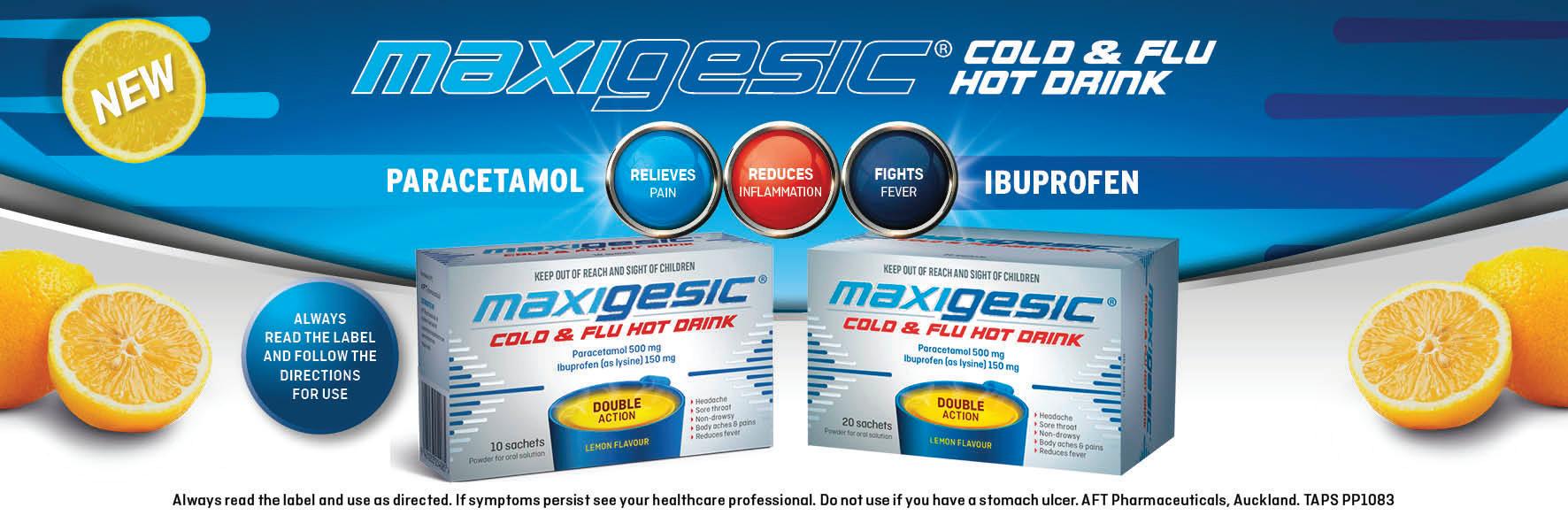

The COVID-19 pandemic has catalysed a heightened interest in personal health and wellness, leading consumers to take greater responsibility for their wellbeing. AFT Pharmaceuticals has observed this trend and experienced substantial growth in the over-the-counter medicines sector. AFT’s liposomal vitamin C product, Lipo-Sachets, has grown remarkably since the pandemic began.
Looking ahead, AFT Pharmaceuticals is poised for continued growth and innovation. With over 70 new products set to be launched in Australia and New Zealand in the next three years, including potential pre and probiotic offerings, the future holds great promise for this growing Kiwi success story. n

Professor Julia Rucklidge from the University of Canterbury has an online course about nutrition and wellness. Rucklidge trained as a clinical psychologist over 25 years ago in Canada.

Amid her PhD, her supervisor Bonnie Kaplan told Rucklidge about families in Southern Alberta, Canada, who were using nutrients, specifically vitamins and minerals in a pill form, to treat severe health disorders, including bipolar disorder and depression. Throughout her training, Rucklidge had been taught that nutrition was irrelevant to brain health.
“It was a bit of a disconnect with my education to hear about these stories. These families were claiming to be doing very, very well with additional nutrients to the point where some of them no longer needed medications,” said Rucklidge.
Rucklidge completed her post-doctoral training in Toronto and moved to New Zealand in 2000. However, she kept hearing of Kaplan’s research, which was publishing interesting preliminary findings regarding nutrients and brain health, which prompted Rucklidge to undertake to study it herself with the mindset that either her research would prove that they did not work, which would be of help to individuals investing in purchasing supplements, or it would prove that it did work, which would again be beneficial public knowledge.
Therefore, Rucklidge began clinical trials approximately 15 years ago. The publishing data made her realise that what she was taught in training was entirely incorrect, as her research (and that of others) showed that micronutrients were central to brain health.
Secondly, she learned that the vitamins and minerals used in her clinical trials, which have specific dosages, were making an incredible impact. Rucklidge emphasised that consumers checking the dosage on the label of the supplements they take was imperative, as products can be marketed based on the presence of an ingredient rather than whether its presence is sufficient to execute the benefits of the said vitamin or minerals.
With growing consumer consciousness on health and well-being, specifically, a drive to build healthier habits following the pandemic, Rucklidge warned that the percentage of ultra-processed foods which are marketed with terminologies associated as a health benefit, for example, ‘plantbased’, are foods consumers need to be wary of due to their micronutrient profiles and as Rucklidge cautiously stated, could be toxic to consumer health as research is showing that consumption of ultra-processed foods is a significant risk factor for poor mental health outcomes. Rucklidge quickly commented that there were plant-based products that were indeed healthy. However, the trained clinical psychologist and professor emphasised concern over the liberal use of specific labels and terms associated with health that are not accurate indicators of the health value of a product when the processing and actual nutrient levels were correctly assessed.
“It’s empty advertising.”
Furthermore, Rucklidge cited NZ research that showed that 42 percent of two-year-olds’ diet was made up of ultraprocessed food, increasing to 51 percent as children reach the age of five, which are critical years of development during children’s lives.
The concern Rucklidge shared over the labelling and actual nutrient value of foods was centred around her concern for New Zealander’s health and the chronic illnesses many New Zealanders face, an issue Rucklidge iterated should be a concern for all. Rucklidge revealed further that the average New Zealander consumes 37 teaspoons of sugar every day, posing the question of where this is coming from.
“The food industry could play an important role in reversing [chronic illness] by stopping selling these types of products to consumers and being concerned about the health value of their foods.”
Rucklidge revealed that processed foods dominate New Zealand supermarket shelves, estimating that 69 percent are over-processed. The research Rucklidge conducted has shown that vitamins and minerals in specific dosages for optimum efficiency for mental health improved psychological function and mood regulation, with decreases in stress with improvements in attention, which
suggested to Rucklidge that the foods people are eating are not nutritionally adequate.
Rucklidge further shared concern over the significant increases in food prices, with difficulty for those on low incomes to eat well, given the direct relationship between wellness and food consumed.
“How is it that 20 percent of New Zealanders are food insecure?”




The clinical psychologist shared that with New Zealand’s capacity to feed 40 million, that consideration into prioritising New Zealanders being fed must be addressed.
When advising consumers, Rucklidge shared that while ultra-processed foods don’t need to be wholly eliminated from diets, it would be best to only take up to 20 percent of consumers’ diets, encouraging consumers to prioritise the intake of whole foods, such as fruits, vegetables, legumes, seeds, fish for its essential fatty acids, and grass-fed beef to avoid creating deficiencies. Rucklidge discussed this was a risk when doing restrictive diets such as veganism or vegetarianism.
When discussing the intake of supplements, the key feature that Rucklidge emphasised consumers and manufacturers alike should prioritise is the dosage of the advertised ingredients. Using the example of fish oil, the EHA and DPA content of
fish oil supplements was imperative to investigate. One gram is the minimum requirement for the supplement to make any impact consumers desire based on their reason for purchasing it. Furthermore, specifically for fish oil, those older and seeking joint relief must consume more to feel the supplement’s benefits.
Rucklidge shared that she believed there should be regulation on the products. However, the issue was complex as supplements are technically food.
When advising manufacturers on the health of producing their products, she encouraged consideration of pesticides used for crops as these can have health consequences.
From her research, Rucklidge hopes that it could impact the population, government, and food producers to recognise and take responsibility for the effects of food on the health of New Zealanders. She pointed out that there were many ethically minded food producers. However, some still needed to address the implication and consequences of their products for consumers. Secondly, Rucklidge hoped the research would support broader knowledge and awareness of the connection between nutrition and psychological and physical health. n

Little Island, the New Zealand brand well known for its award-winning dairy alternative ice cream and ice blocks, yoghurt and milk, has taken a fresh look at the supermarket offering with the launch of its new blended milk range into stores this April. The range includes
Blends make for better-tasting and more balanced milk and deliver more functional health. All Little Island milk is unsweetened, providing 25 percent of daily calcium, D2
and B12, and is phosphate-free. These milks go well on their own or in smoothies, cereal, and breakfast bowls, and all four can be foamed and added to your daily coffee.
For more information, visit www. littleislandcreamery.co.nz or Email the team at orders@littleislandcreamery.com. n
The parent company of Keto Food Co, Conscious Foods, was founded by James Ehau, Tamati Norman, and Mikki Williden, who are passionate about healthy living and creating a positive impact in people’s lives through better nutrition.
The three founders met through a mutual interest in health, nutrition, and fitness. The trio quickly discovered they shared a common vision for creating ketofriendly products and promoting a healthier lifestyle.
Ehau’s journey into the keto world began after the passing of his father from type 2 diabetes in 2004. He learned that a keto or low-carb diet could have potentially reversed this condition, which sparked his
interest in promoting better nutrition.
As a personal trainer at Les Mills and an entrepreneur, he set up one of the first companies to sell keto products in the US in 2016. However, due to the Covid pandemic, he returned to New Zealand and wanted to help bring keto-friendly options back home.
Norman’s background was in food import and export to and from Papua New Guinea, which provided valuable experience
and insight into the food industry and Williden, who is a nutritionist with a PhD in nutrition, added her scientific expertise to ensure that Keto Food Co’s products were both delicious and nutritionally sound.
Mikki, a nutritionist with a PhD in nutrition, added her scientific expertise to the team, ensuring that the Keto Food Co’s products are delicious and nutritionally sound.
The Keto Food Co brand was launched in 2021. After
extensive supply chain and brand development, the company landed on supermarket shelves with Foodstuffs in May 2023.
Keto Food Co has aimed to make keto-friendly alternatives to traditional food products easily accessible and enjoyable for the more health-conscious consumer.

Crafting keto products combines a need for science, nutrition, and culinary expertise. The trio ensures that each area is fulfilled through extensive personal research into the ingredients used, the nutritional values, and the compatibility with the keto lifestyle.
However, this poses challenges as the current food service ingredients contain high sugars and starches. Therefore, the vetting process and lead times can be lengthy.
The Keto Food Co engages
with health professionals throughout their product development process, collaborating with nutritionists, doctors and other health experts to gather their insights and expertise to ensure the brand creates well-rounded products that cater to the needs of consumers while maintaining scientifically supported nutrition. Since the brand’s inception, it has consistently evolved to meet consumer demands.
“We have expanded our product range, fine-tuned our recipes, and strengthened relationships with our supply chain partners to serve our customers better,” shared Norman.
Norman shared that the three founders had noticed a significant shift in consumer behaviour towards healthier and more
sustainable food choices in recent years.
“People are becoming increasingly conscious of the ingredients in their food, the nutritional value of their meals, and the impact of their consumption habits on the environment.”
This has directly impacted the market, creating important growth opportunities for products to cater to consumers’ specific dietary needs, such as keto, paleo, and plant-based options. As a result, Keto Food Co has seen a steady increase in demand for its supplements, food products, and ready-made meals.
Keto Food Co’s products are all formulated to be low in carbohydrates to support those on keto and low-carb diets to maintain their desired macronutrient balance. Secondly, Norman shared that the brand’s products were nutrient-dense, with no added sugars or artificial sweeteners. Thirdly, the brand was proud to create convenient and accessible products, including ready-made meals for the busy consumer to easily stay on track for their desired diet, keto or otherwise while having guaranteed, flavourful food. While the brand’s range is geared toward low-carb, keto consumers, Keto Food Co has witnessed growing interest from non-keto consumers due to growing consciousness about health and well-being.
Norman shared that three founders expected the keto movement to continue gaining traction and popularity with consumers as people become more knowledgeable about its health benefits, particularly how it can support varying health conditions.
However, Norman shared that challenges moving forward included the risk of misinformation and misconception about the keto movement.
“There may be an influx of misinformation and misconceptions about the diet. Ensuring that consumers have access to accurate, science-based information will be crucial in maintaining the credibility of the keto lifestyle.”
To manage these challenges, the brand has committed to maintaining close relationships with health professionals and nutrition experts to provide reliable, evidence-based information on its products and the keto diet, including monitoring regulatory changes and continued innovation and product development to stay ahead of its competitors.
As consumer demand for health-based products has increased, Keto Food Co has committed to incorporating market research and customer feedback to create products aligned with consumer interests. Furthermore, the brand has noticed a trend towards natural, clean ingredients, functional ingredients, and global flavours, which Keto Food Co has stayed attuned to and implemented into its product development.
To manage the disruptions caused by the pandemic, Keto Food Co focused on diversifying its supplier to reduce the risk of relying on a single source for raw materials or components. Secondly, Keto Food Co prioritised the safety of stock and developed robust contingency plans to address varying potential supply chain disruptions.
Maintaining strong relationships with suppliers, monitoring global trends and making risk assessments whilst being flexible and adaptable were key features of Keto Food Co’s navigation throughout the pandemic.

“By implementing these measures, we strive to manage supply chain disruptions proactively and ensure the continuity of our business, even in the face of unforeseen challenges.”
For sustainability, Keto Food Co prioritises ethically-sourced, local, and fair-trade ingredients where possible, optimising manufacturing techniques and minimising packaging materials to reduce waste throughout the brand’s production process.
Norman shared that the company makes an effort to work with like-minded conscious companies who adopt and utilise energy-minimising practices. However, Norman also shared
that the brand focused on using eco-friendly and recyclable packaging materials, with a particular focus on soft plastic recycling.
Furthermore, the brand also encourages sustainable practices with its employees both in and out of work, committed to making a change on both personal and professional levels.
Technology also plays a significant role in Keto Food Co’s strategy as it supports streamlining its operations, enhances customer experiences, and reaches a wider audience.
Norman shared that the company leveraged technology through seven key points, an E-commerce platform, digital marketing, customer relationship management (CRM), data analytics, supply chain management, automation process optimisation, and collaboration and communication.
The brand’s E-commerce platform allows it to sell directly to consumers, and it utilises many different digital marketing challenge to generate greater activity, including social media, email campaigns, and online advertising.
Keto Food Co utilises CRM software to manage customer relationships and interactions, where the brand can give consumers personalised services and advice and gather valuable feedback. This feedback in reference to the brand’s data analytics, where it can gather insight on consumer preferences, shopping habits and upcoming market trends.
Furthermore, Keto Food Co leverages automation and process optimisation through digital tools and technologies to automate repetitive tasks and optimise processes throughout the organisation.
Lastly, digital technology allows the company to communicate with its team regardless of location.


“By leveraging digital technology in these ways, we aim to drive growth, improve our operations, and enhance the customer experience, ultimately positioning our business for longterm success.” n


With the growth of knowledge about health and wellbeing from consumers, in conjunction with the increased concern over environmentalism, consumers have become more vigilant about their purchasing decisions, taking into account the whether a product is organic, whether ingredients are locally sourced, as well as avoiding products containing long ingredients lists of including artificial flavours, colours, and any other nonorganic or natural additives.
Thus, the market for Clean Label products and ingredients has significantly grown. In 2022, the global market was valued at USD 38 billion. It was expected to continue robust growth over the next decade at a CAGR (compound annual growth rate) of 16 percent, according to FMI (Future Market Insights).

This increased demand for products cultivated using authentic, natural, and organic ingredients are driven by the consumer focus on health, with growing concerns over the impacts of products consumed on the body and mind.
The pandemic is one key feature that has driven the health-conscious consumer and the clean-label market. Furthermore, upcoming labelling changes, requiring manufacturers to specify allergens instead of using blanket terms, reflect this movement towards consumers’ desire to quickly identify ingredients, allergens, and the products’ true nutritional value.
Consumer demand for clarity and transparency of the contents of their products, including where ingredients are sourced and whether the manner they are sourced is both ethically and environmentally conscious, are key aspects propelling the growth and market opportunity for clean label products.

As consumers have become more knowledgeable and have begun scrutinising the ingredients of the products they consume more closely, this has led to significant changes for manufacturers, with many investing in research and development and innovation to cater to these consumer demands.
Furthermore, while consumers are more often basing purchasing decisions based on clean-label ingredients, they are not
willing to compromise on flavour and taste, pushing manufacturers to innovate solutions to cater to both the health benefits of clean-label products that consumers want while maintaining product flavour profiles.
Consumers’ behaviour and brand loyalty have also significantly shifted, with consumers more readily willing to switch the brands they usually buy from if another competitor has products more aligned with their values and tastes.
One of the main challenges of developing clean label products is the lengthy process as the innovation of traditional products to clean label includes the removal of highfunctioning, and established ingredients that have been long used for specific purposes, thus replacing these ingredients with clean, organic, and natural counterparts without compromising flavour or texture poses a challenge for manufacturers.
However, the popularisation of cleanlabel products and ingredients have created significant growth opportunity and has given those adhering to clean-label benefits has provided a key differential point to appeal to consumers. n
Demand for clean-label products has significantly increased as consumers have become more conscious of health and nutrition and seek transparency in their products. The head of Marketing at Tom & Luke, Rachel Morrison, revealed that the pandemic accelerated the consumer focus on better-for-you products that could be viewed as an opportunity to indulge or treat oneself.
hese trends are completed aligned with the Tom & Luke snack range, which are all based on real food with clean ingredients while also being a satisfying sweet treat, without the guilt,” said Morrison.

Tom & Luke’s snacks range is crafted from natural ingredients such as nuts, seeds and fruits, with no added sugar, sweeteners or sugar alcohols in the brand’s Snackaballs™ and no refined sugar in any of the brand’s chocolate coatings. Each product is glutenfree and non-GMO and Tom & Luke includes a range of certified vegan products.
As a Toitū-certified net carbon zero company, Tom & Luke’s packaging reflects its clean label ethos through its 100 percent recyclability through the soft plastics recycling scheme. However, the company is also part of Toitū’s carbon reduction programme, with Tom & Luke’s progressing towards becoming a certified B Corp company.
Morrison’s extensive corporate experience at the likes of Lion, Coca-Cola United Kingdom and Pernod Ricard, alongside her work with smaller, entrepreneurial New Zealand businesses such as Essano Limited and Tom & Luke, has given her the knowledge and skills to lead the development of Tom & Luke’s clean ingredient innovation pipeline, brand
strategy and marketing execution.

“I learned a lot from those companies, brands and colleagues. Since having a family, I’ve been doing more consultingtype work and have worked for smaller, entrepreneurial New Zealand businesses, which has also been amazing,” said Morrison.



Morrison shared that she’s had opportunities to create brands, develop and execute strategy and drive innovation which has taught her to be agile and creative, which the head of marketing enjoys.
However, Morrison shared that the pandemic posed challenges for the Tom & Luke brand as consumer snacking behaviour and the ability to unlock export opportunities drastically changed. Having overcome these challenges, the brand has shown continued growth in local markets. Morrison said the brand could deliver exciting growth opportunities in export markets, entering an exciting growth phase for the company.
Morrison shared that Tom & Luke’s had a custom-made manufacturing capability, which has resulted in the company operating at a unique scale concerning its Snackaball™ products.
Tom & Luke has also launched an exciting new product named ChocaDate Minis. The new snack is crafted with tiny pieces of date smothered in Tom & Luke’s signature refined sugar-free chocolate.

“We have two flavours, dark choc and white choc blueberry. I keep trying both to work out my favourite.”
When discussing her favourite snack from the Tom & Luke range, Morrison shared that she was a fan of the brand's softly textured reduced sugar range as an everyday option as it contains 50 percent less sugar than the rest of the Snackaball™ range.
“They are delicious and great in lunchboxes too. However, it’s also super hard to go past our choc coated Snackaballs…they are so good.” n


Established in 1990 as Garden City Coffee, then rebranded to Hummingbird
Coffee in 2000, Country Manager for New Zealand, Nick Cowper, shared that Hummingbird has become more than a brand.
“It was a way of doing business. That is why my family and I started roasting coffee in 2000,” Cowper said.
Cowper explained that for over 30 years, Hummingbird had been built on the principles of people committed to being involved through every step of the process, from crop to cup. This commitment has allowed the brand to cultivate relationships based on trust, sourcing beans from farmers
Hummingbird knows and supporting the communities of growers.
Known as a specialty coffee brand, Hummingbird is committed to delivering high-quality, distinctive coffees crafted to impact the communities the brand has relationships with positively.
In 2004, Hummingbird became an early champion of fair trade in New Zealand, being one of the first in partnership with Trade Aid to directly import fair trade, organic, and green coffee beans.

Hummingbird maintains relationships with coffee growers and pays a premium for fair trade organic coffee beans.
Since 2005, Hummingbird has donated over 10 million dollars in premiums to tens of thousands of growers and their respective families in 10 countries, reflecting the company’s ethos of sustainable coffee sourcing.
“The entire Hummingbird coffee range is 100 percent organic certified through our certification partner, AsureQuality. It is important to Hummingbird to work with farmers that grow coffee in a
way that makes the land they cultivate healthier, safer, and the coffee they produce is higher quality.”
The brand’s certification through AsureQuality has ensured that Hummingbird follows a stringent process to prevent non-organic chemicals from entering the source and production cycle of the brand’s product at any point.
Cowper described that before COVID-19, consumer behaviour had shifted towards buying organic and cleanlabel products, with consumer awareness around health and well-being incrementally growing, which was accelerated due to the pandemic.
Consumers are motivated to consume healthier products, including consideration and purchasing choices driven by how products are sourced and produced. This has prompted the demand for organic and clean-label products.
For the future of organic products, Cowper explained that the stabilisation of the economy following the pandemic, and the increase of consumer education around organic products, will result
in significant growth for the category as the health and environmental benefits of such products become more commonly understood.

Furthermore, Cowper predicts that more companies will move their entire range of products to 100 percent organic, rather than having only one or two organic certified products, making these practices standard rather than a specialty.
Hummingbird’s process for manufacturing is underpinned by a depth of understanding that coffee beans from different countries represent different characteristics that should be accounted for when roasted.
“We roast all our single-origin green coffee individually to get the unique flavours and characteristics of each origin.”
After the beans have been roasted, they are blended to create some of the brand’s most iconic coffee blends, including Oomph!, Nectar, and Crave.
Each coffee blend is packed within hours of roasting to ensure freshness.
In conjunction with the organic certified and fair trade sourcing of its coffee beans, Hummingbird ensures


sustainability and efficiency by investing in relationships with farmers who consciously care for the land crops are grown on. Secondly, Hummingbird invests in its equipment to keep its roasting operations up-todate and efficient. Thirdly, each product is directly delivered to stores and cafes to reduce freight time.
Finally, Hummingbird’s products are packaged in recyclable soft plastics to reduce waste going to landfills and environmental impacts, as the brand participates in New Zealand’s soft plastics recycling scheme. Customers can take their Hummingbird packs to their nearest supermarket with a soft plastics recycling bin or directly to the Hummingbird Experience Centre in Christchurch.
Cowper shared that while the uptake of organic clean-label products has been steady, it faces challenges based on knowledge around the benefits and impacts of organic products and lack of regulation around what can be labelled as organic. Companies currently can call a product organic without being certified. This can cause both confusion
and distrust within the industry and for consumers.
Another challenge for the category is its price point and accessibility.


However, Hummingbird remains proud that throughout the challenges of the pandemic, it has maintained an entirely 100 percent certified organic range, with the brand committed to continuing to deliver high-quality, fair trade organic products.
“As the market leader in fresh coffee, we must continuously educate our consumers about organic certification and lead the way of making specialty grade fair trade, certified organic coffee affordable and easily accessible.”
Cowper revealed that consumers should pay attention to the brand’s next singleorigin coffee from its Harvest range, as it will be sourced from the Marcala coffee region in Honduras.
The Country Manager iterated that the co-operative where the beans are sourced, Café Orgánico Marcala SA, was founded in 2001 by 69 farmers who set out to encourage quality and organic agriculture.
Over the years, the cooperative has cultivated over 1,200 members producing specialty-grade organic coffee, focusing on agricultural and social development. The cooperative has a school and operates organic education classes for farmers in various parts of the region and country.
“This next single origin has been developed to pair beautifully with oat, almond, and soy milk for a full, rounded mouth-feel. It has indulgent and bitter notes of dark chocolate with a hint of concentrated and sweet fruity notes of sultanas and vanilla.”
The new single origin will be available in most supermarkets in a 200g bag of coffee beans or plunger grind from the beginning of June.
Cowper shared that despite enjoying mixing up his coffee brew and blend, his personal favourite Hummingbird product was Oomph! for its versatility and fruit characteristics. n
The entire Hummingbird coffee range is 100 percent organic certified through our certification partner, AsureQuality.
Registered Nutritionist Sara Lake has worked in Quality Assurance and Operations. New labelling requirements will have more stringency around allergens, impacting manufacturing significantly.
Lake shared that while it has significant impacts, some manufacturers will be affected more than others.
“The impact on the industry will vary depending on the products made,” said Lake.
Lake explained that the critical factor affecting manufacturers would be the separation of allergens in storage, transport, and processing.
“Where previously, companies may have had one area of the warehouse dedicated to gluten-containing cereals or fish products, now they will have to separate products that contain wheat and keep their fish, crustaceans and molluscs separate.”
Consequently, this will create difficulties for dedicated equipment when handling a single defined allergen. Lake explained that while cleaning processes would minimise cross-contamination, the new labelling requirements may result in consumers noticing more the industry standard term, ‘it may contain traces of’ on product labels.
The increase of this statement on packaging will be the company’s method of guarding against the risk that traces of wheat have made their way into a cereal marketed as oat-based. Previously, these two products would have been under one identifiable label as a ‘gluten-containing cereal’, which would need to be specified separately with these changes.
Lake shared that Standard Operating Procedures around handling allergens and cleaning between products may need to change and be re-documented, requiring manufacturers to adjust operations to cater to these changes.

The Nutritionist revealed that the U.S.A. was a prime example of how manufacturers can embrace these labelling changes.

“I was very interested in what happened in the US with the new sesame labelling law. Rather than get sued for traces of sesame in products that didn’t have it on the label, companies are adding it into all their products and declaring it on the label.”
Lake shared that this approach was likely adopted because it is a more cost-effective solution than manufacturers completely re-inventing and changing their line cleaning processes.
Another impact that would have a costly effect is the need for design and reprinting of labelling across a multitude of brands and products which are not already compliant by the end of the transition phase in February 2026.
While there are technically no new allergens to be advised, allergens were previously under a single identifiable category. For example, gluten-cereal, fish, tree nuts and otherwise would be required to be specified either with more depth or made more evident on the label.
The Nutritionist revealed that while these may have significant impacts on manufacturers, the specifications for consumers of having allergen identified with more detail would be reassuring for those with allergies. For example, Lake shared that having ‘tree nuts’ means a product containing almonds or walnuts would help consumers make more informed purchasing decisions.
However, Lake shared that it may be surprising for non-allergic consumers to see more allergens emboldened on a product’s ingredients list. Furthermore, the specification requirements may also impact a brand or company’s ability to market their products to consumers, potentially limiting their opportunities to claim their products are free from specific allergens. n

The CEO of Ceres Organics, Alex Player, shared that he has always worked with the FMCG (fastmoving consumer goods) industry, starting in the United Kingdom before migrating to Australia and, finally, New Zealand. Player worked in various roles, including sales, marketing, human resources, and procurements.

“Iwas lucky enough to work for large multi-national companies such as PepsiCo and Lion, which had incredible internal development programs,” said Player.
Player elaborated that his roles in these companies were complemented by their significance in food service and distribution, allowing him an in-depth insight into the complex structures of multi-category companies and international trading.
When discussing what drew him to Cere Organics, the CEO was inspired by the company’s purpose to bring healing to the earth and humankind, as the company’s philosophy is rooted in the idea that business plays a significant role in addressing the social and environmental challenges that the world as a whole is facing.

Ceres Organics challenges itself on how it can conduct business better through informed, purpose lead decisions that balance financial sustainability with making environmentally conscious decisions that positively impact the community.
With Ceres Organics’ position as a clean, organic product company, Player has noticed a significant rise in conscious consumption, which the company calls a ‘groundswell’.
“Consumers are more conscious of their health as we are challenged with rising obesity, allergies and autoimmune conditions, but also of the health of the environment and the planet we inhabit.”
Player elaborated that consumers are becoming increasingly interested in the contents of the food they consume, how its prepared, where it comes from, and notably, the environmental and social consequences of its production.
Certified organic products are a way in which consumers can discern between products that align with their values, as it assures that certified products are produced harmoniously with nature and with consideration of social consequences, which ensures quality and fairness for producers.
Ceres Organics has developed a trusted network of supply partners from yearslong relationships. Sourcing both from
New Zealand and globally, the brand is specific about where it procures products based on the quality of the product and the environmental and social consequences.

Many of Ceres Organics’ supply partners are deeply invested in their local communities to enhance well-being. As a result, Cere Organics supports the global growth of organics. It also ensures that the brand can bring products to the shelf of high quality and nutritional value to its customers.
Player believed that the improved understanding of the negative impact of the conventional agricultural systems on the environment, individual health, the taste of produce and the conditions many agricultural workers have to endure is the most significant driving factor behind consumer interest in clean, certified organic products.
“We are in a global community’s political, environmental and social crisis. The inability of Earth to sustain our current conventional food production systems is becoming more evident as we face the impacts of global warming, natural disasters, water pollution, soil degradation, and the list goes on.”
The CEO stated that consumers taking action in their purchasing to address these issues had been made evident by the increased growth of organics, biodynamics and regenerative agricultural products.
Player stated that consumer purchasing has changed with growing consciousness and knowledge of the impact of food choices, therefore price points are not the singular mode of the reasoning behind consumer decision-making, with consumers taking into consideration the ‘trust cost’ of food, meaning the value of the products in regards to consumers personal health, the impact on the environment and on the social welfare and dynamics of those involved who produced the product.
Player explained that consumers often journey into clean-label organic products begins through more competitively priced categories such as snacks. Ceres Organics has a wide variety within the snacking category, including seaweed snacks, rice crackers, rice cakes, raw bars, pea chips and popped rice chips.
As this is an entry point for many consumers into organic products, ensuring the quality of taste and nutritional health benefits at an affordable price point makes all the difference.
To become certified organic, there are manufacturing requirements that are not required when conventionally manufacturing a product.
To be certified organic an independent organic certifier visits the farm, processing facility, or warehouse to inspect and organic status of the facility, administration and production
However, this inspection excluded the examination of aspects such as soil or crop samples, product handling procedures, equipment cleaning protocols and agents used, pest control practices (no fumigation and synthetic chemicals allowed), administrative assessments (documents and paper flow) and many other details, which Ceres Organics chooses to implement themself to create a regenerative process from every possible point of a products lifescycle through production.
“Every step of the production chain is certified according to worldwide organic standards. And at every stage of a change hands, a record is generated, which must be reviewed and approved before advancing to the next stage.”
As a result, the chain of organic certification is a connection from the farm to when it leaves the warehouse door, to ensure a fully traceable food system.
Player revealed that every product under Ceres Organics has been checked, audited and certified by our trusted third-party certification agency, which is the only way to achieve organic certification and is a process repeated through yearly inspections.
However, one challenge Ceres Organics faces is regarding packaging. The company has strived and continues to try and develop more environmentally friendly packaging solutions. Still, Player stated the company is not satisfied with either its own or the industries, progression towards this.
“We have tried to partner with suppliers to develop and launch packaging innovations such as home compostable packaging, but without broader industry and political support, we have found this difficult to maintain. We are committed to improving in this area.”
Furthermore, Player shared that the brand’s other greatest challenge was building a community around clean organics with a shared understanding, education and knowledge base. While the CEO said it was happening, he questioned the rate at which it was happening and whether it was fast enough to address the current environmental and social challenges.
Ceres Organics supports various environmental and industry actions group, including GE Free Northland, and invests in education programs for its team members and consumers through social and digital media.
The brand has recently launched its new Pea Chips in New Zealand in three flavours, Salted, Salt & Vinegar and Salt & Pepper, which Player described as incredibly popular, having won the Food Product of the Year at the Organics New Zealand Awards.
The CEO stated that his favourite products were the Pea Chips and the brand’s rice crackers and cakes. n



Order pickers, pallet and reach trucks, pedestrian stackers – all essential parts of any warehousing componentry, but are any of these considered forklifts?

It might seem like a stupid question, especially to those long in the tooth, but it is really important to understand the different types of equipment at your disposal if you’re to follow every letter of the Health and Safety at Work Act 2015.
A good place to clarify the definition of a forklift is the Forklift Industry Association of New Zealand’s new Forklift Good Practice Guidelines (GPG).
You might have read about this in a past Supermarket News issue but if you haven’t, it’s a document that contains guidance on how to achieve industry good practice within your workplace as well as maintaining operational compliance with current rules, regulations and standards.
We’re optimistic that the guidelines will be endorsed as the replacement of the Approved Code of Practise of Forklift Training and Operations Practice.

But back to the question at hand: what is a forklift?

The GPG defines them as a powered industrial lift truck equipped with lifting media made up of a mast and elevating load carriage with a pair of fork arms or other attachment that can be raised 900 millimetres or more off the ground.
Bluntly put, it is something that lifts goods off of one surface and onto another using a vertical mast.
Forklifts are used for a wide range of operations in New Zealand and are invaluable assets that provide key services within the materials handling sector for multiple industries.
And there is a myriad of forklift classifications; as with all mobile plant, the safe operation of forklifts depends on multiple factors, including the correct selection of forklift and attachments for a given task.

Forklift operations present a significant risk if those factors are not managed correctly, which is why it is important to make the distinction because it creates a clear set of expectations for the users or operators of the
equipment.
Correct forklift definitions, or indeed selection, are vital as it plays a role in training which is separated into three parts: foundation training, workplace training (including ongoing competency assessment) and refresher training.
A competent operator is one who has the means of demonstrating competency through the combination of the following:
• The holding of nationally recognised Forklift NZQA unit standards appropriate to the type of forklift, and
• Successful completion of role-specific workplace training on the type of forklift they operate, and
• Ongoing competency assessments.
One means of demonstrating competency is through achieving nationally recognised Forklift NZQA unit standards or an equivalent or higher qualification. Competency should also be assessed through supervision during the use of the equipment. A forklift operator must also be able to demonstrate they have the knowledge and skills required to carry out an effective hazard and risk assessment within their area of operations.
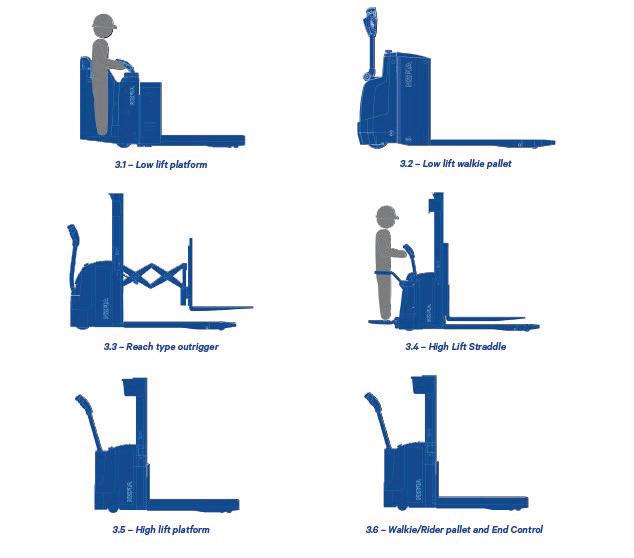

This all might seem fairly obvious, but sometimes it bears repeating in any industry that relies on equipment with inherent risks. The GPG is comprehensive and detailed to keep our people, our mobile plant and our operations safe.
It has been developed this way also to ensure that everyone is aware of their duty of care, obligations, and responsibilities regardless of who they are.
The GPG might not get you a spot on the now cancelled World Forklift League (which featured on New Zealand televisions back in 2015) but it better reflects current best practice for those involved in operations that involve forklifts, and will go a long way to helping you and others stay safe. n
We’re excited to announce the Peter Mitchell Memorial Golf Day, where we’ll be teaming up with the Graeme Dingle Foundation to raise funds for Kiwi Can and the amazing Peter Mitchell Scholarship. This scholarship is perfect for anyone looking to further their knowledge and training in FMCG, fashion, and hospitality. Peter Mitchell was an industry legend who received the FGC Lifetime Achievement Award twice, as well as numerous other awards during his lifetime. He was passionate about supporting and nurturing talented individuals in these fields, and this scholarship is a wonderful way to continue his legacy. By joining us for the Peter Mitchell Memorial Golf Day, you’ll be supporting Kiwi Can and helping to create a brighter future for aspiring professionals in these industries. So come join us for a fun day of golf and giving back!



(*rain day 7 August)
237 Alfriston-Ardmore Road
Papakura, Ardmore
We’re hosting an awesome end-of-play auction and we’ve got some great spot prizes lined up too. If you’re keen to join us, it’s just $300 plus GST for an individual player (and we’ll put you in a team if you don’t have one), or $1000 plus GST for a team of four. A great day of golf at a world class course while catching up with industry colleagues - we hope you’ll join us.
Ambrose,
Kungfood’s new Big Spring Rolls are freezer-to-table, restaurant-quality spring rolls prepared faster and hotter than delivery food and at a fraction of the cost.
Available in three different flavours, Asian Beef & Cabbage, Lemongrass Chicken, and Vegetable. These spring rolls will transport customers to their happy place whilst giving taste buds a karate kick. The spring rolls are purposefully generously sized for a higher filling-to-pastry ratio.
The Kungfood Spring Rolls 280g can be found in the freezer at Count-down (nationwide) and New World and Pak N Save (South Island only).

Rj’s are thrilled to have launched four new Fabulicious packs this week, giving Kiwis more sour, gummy, Sherbert-filled choices at the checkout. Now available nationwide at leading retailers, these mouth-watering treats satisfy any sweet tooth.
New flavours include Fabulicious Duos Gummy Rings, these fruity gummy rings with double flavours can create unique combos when eaten together. Secondly, Fabulicious Duos Two-Headed Snakes are gummy snakes with a twist, a head at both ends and mixed fruity flavours.


Fabulicious Duos Sour Gummy Rings are sour circles of delight with a fruity double-flavour mouth explosion.
Finally, Fabulicous Sherbert Fizz Mixed Flavour includes RJ’s fan-favourite Sherbert Fizz, in flavours raspberry, tropical, and green apple, in the ultimate party pack. RJ’s take pride in ‘Making Things Better’. The new Fabulicious lollies range is made with only the best ingredients and is 100 percent palm oil free with no artificial colours. n
In a blend of South Island-grown and pressed sunflower oil and its award-winning creamy Butter, Westgold has launched its new spreadable Butter. Hamish Yates, Westland Milk Products’ General Manager of Sales and Marketing, revealed that the launch of the spreadable Butter was a response to increased consumer demand for soft and easy-tospread Butter, even at cooler temperatures.
“We have collaborated with our friends down the road at The Good Oil to blend our West Coast butter with a dash of their cold-pressed sunflower oil,” shared Yates.
Described as an exceptional product, Westgold’s new spreadable Butter has a golden colour and deliciously creamy flavour for which the brand is renowned.
Yates stated that the Westgold story was centred around locally sourced milk from
a handful of West Coast farms below the Southern Alps. “The fresh cream is then churned by master butter makers using the traditional Fritz Churn method.”
As two South Island brands, the collaboration is proud for Westgold and The Good Oil. Nick Murney, the Managing Director of the Canterbury-based Pure Oil New Zealand Limited, the umbrella company behind The Good Oil, shared that the sunflower oil used in Westgold’s spreadable Butter was all cold-pressed at the company’s crushing plant in Rolleston.
Yates shared that the product has experienced significant popularity, particularly in Australia, for its flavour profile which has a high proportion of salted Butter, 27 percent of which can be attributed to the sunflower oil used. “We will be looking to export to other markets. It is a great product, and we look forward to seeing its growth.”
Westgold’s products are available for purchase at New Zealand supermarkets. To learn more about Westgold, visit westgold.com. n

Angel Bay has created a new, exciting flavour to stand out from the rest of the brand’s range, highlighting chef Mark’s culinary skills into a burger that can be enjoyed at home. The outcome has resulted in Angel Bay’s new limited edition Angel Bay Smoky, Tangy & Cheesy Beef Patties. The patties are beefy, sweet, sour, smoky, and cheesy, taking the taste buds on a journey of perfectly balanced flavours, resulting in a great-tasting and enjoyable burger. Full of gooey cheese, tangy gherkins and smoky deliciousness, Angel Bay’s new patties are a flavour bomb for any burger. Available exclusively, for a limited time, at New World, Pak n Save or Four Square nationwide. n

Air Wick has introduced Botanica, a new Automatic Spray Start Kit. Botanica’s first auto spray is aerosol-free and programmed to automatically spray inside the home with delicate fragrance for lowmaintenance air freshening. Each refill lasts up to 70 days** to deliver 24/7 freshness. The auto spray also comes with a boost button to provide an extra burst of scent, and adjustable intensity, to cater for a more subtle, delicate aroma. With a selection of scents, each Botanica refill is compatible with the Botanica Automatic Spray Starter Kit device to make swapping fragrances as seamless as possible. n


Meal planning has been made easier with Mr Chips’ delicious ready-to-serve roast potatoes with a gluten-free option also available. Mr Chips Rosemary & Garlic or Mr Chips Agria Roasties are perfectly cooked, made with only the freshest and highest quality ingredients, ensuring maximum flavour in every bite.


With convenient reheating options, either through an oven or air fryer, customers can enjoy mouthwatering roast potatoes any time without the hassle of preparing them from scratch. With crispy exteriors or soft and fluffy, Mr Chips has a range to satisfy every taste preference. Mr Chips Roasties are the perfect addition to any family meal.
For more information contact Mr Chips at www.mrchips.co.nz. n



Family favourite Maggi is helping Kiwis put tasty, easy meals on the menu by launching two new flavours, Chinese Fried Rice Recipe Mix and Air Fryer Crispy Salt & Pepper Seasoned Coating. These new additions to the Maggi range inspire cooking at home, with natural herbs and spices blended locally in New Zealand. The new Crispy Salt & Pepper flavour mix, perfect for chicken bites, calamari and tofu, will tempt the taste buds for lunch, dinner, or Friday at home ‘fakeaways’.

The new flavours are available at supermarkets nationwide.

Steady supplies of vibrant orange persimmons are heading to stores around the country as May signals the beginning of the season for this unusual exotic fruit.
Available for just a short time, retailers are encouraged to make the most of persimmons from now until late July.
Ian Turk, Manager of the New Zealand Persimmon Industry Council, says progress is on track for the season.
“Persimmon growing areas are across the top half of the North Island, which has meant that our growers have felt the full force of the cyclones (Hale and Gabrielle) which hit in early 2023,” he says.
“Fortunately, our orchards have largely escaped structural or flooding damage. However, the spring and early summer were very windy and wet, for the second year in a row, and we are expecting our total export crop to be lower this year as a result of that earlier weather.”
While the warm conditions experienced this year favour the fruit which originated in China, the rain and wind driven by the La Niña weather pattern have presented
growers with significant challenges.
“Stressed trees will drop fruit, wet weather causes humidity marking on the fruit, and of course fruit that is blown around in the tree will be marked from rubbing against branches or other fruit,” says Turk.
“Despite this, the fruit quality and taste this season has not been affected. Even if there is some fruit in the market that does look a bit marked, it is sure to still be the great honey-like taste that New Zealanders are familiar with,” he says.
“As the fruit has started to ripen, it’s been pleasing to see that initial taste tests suggest that we will have plenty of large juicy, and great tasting persimmons this year.”
In addition to supplying fresh persimmons to local retailers, New Zealand’s 2023 crop will be exported to eager markets around the world.
“This year the industry expects to be exporting around 1000 tonnes of fresh persimmons to consumers who are waiting for them in Australia, Southeast Asia, Japan, Vietnam, the United States and China,” says Turk.
“The export season will start in April and run through into July. In New Zealand, peak availability for our retailers should in May with slightly lower volumes in June and July. We’re encouraging local markets to make the most of the fruit while they can,” he says.

Commercial persimmon growing operations in New Zealand were initially established to supply the international market.


“Persimmons are a well-known product overseas, particularly in Asian markets. Our domestic supply chains developed more slowly to begin with, but in recent years the popularity of the fruit has increased rapidly,” says Turk.
“Some shoppers still recall the older variety of astringent persimmons that had to be just about falling apart and jelly-like before tannin levels dropped and the fruit was ready to eat. But the modern varieties, mainly Fuyu, are non-astringent and can be eaten crisp just like an apple,” he says.
“Most New Zealand persimmons will be eaten as fresh fruit, but overseas dried persimmons are a real delicacy. Kiwis also becoming much more adventurous with using persimmons in all sorts of exciting new dishes. I’d encourage retailers to profile this season’s persimmons alongside suitable recipe suggestions – the 5+ A Day Charitable Trust website is a great place to start.” n















As “JAPAN’S FOOD” EXPORT FAIR specialises in “Exporting” from Japan, the show is the best venue for purchasing Japan’s foods & beverages. Save the dates and join the show to discover new varieties of products! Register here to get your free ticket.


Consumers are looking for convenient, accessible, healthy, flavourful meal options that align with their ethics, accommodate their lifestyle and don’t compromise on their health and taste desires. These key features are the driving forces behind the increasingly popular frozen, ready-made convenience meals market. This category has seen an impressive upswing in growth and popularity both throughout the pandemic and since.
According to recent data, the global frozen ready-made meals market is estimated to expand from USD 51.1 billion in 2023 to USD 122.4 billion in 2033, at a nine per cent CAGR (compound annual growth rate) between this next decade.
Increasingly manufacturers of frozen readymade meals are incorporating nutritional options alongside vegan and vegetarian options as the growing consumer movement towards plant-based lifestyles for equal parts

health and environmental purposes.
The growing plant-based movement is an area of significant expansion and growth opportunity globally, which consequently has driven the innovation of health-centric ready-made meals as plant-based prioritises fruits, vegetables, whole grains, beans, nuts, seeds and oils, all of which are notably known associated for the health benefits.
Consumers' interest in clean-label products has propelled innovation from manufacturers to use 100 percent natural ingredients in frozen, ready-made meals, as a consequence contradicting the historical stigma of frozen, ready-made foods compromising on health and containing harmful properties and additives.

With consumers becoming more aware of the impacts of their food choices and knowledgeable about their personal health needs, clean-label, healthy products are key innovation points for manufacturers of frozen, ready-made meals to consider when manufacturing. n
Alexandra’s couscous-based Mediterranean gourmet meals are ready in 15 minutes, including flavours Apricot and Currant, Date and Pistachio, Olive and Sundried Tomato, and Mushroom and Pine Nut. Alexandra’s rice and lentils range includes Biryani Rice, Thai Coconut Rice, Rose Harissa and Coconut Lentils, and Turmeric and Coconut Lentils.
Pioneers of the fresh, chilled soup category, True Food brand Pitango, are preparing to lead the way again with the rollout of their highly anticipated new chilled soup packaging designed to offer even better value for the consumer.

Pitango’s fresh soup pouch, rolling into supermarkets this winter, offers a unique, easy-to-open, easy-to-seal zip function. The Pitango soup resealable ziplock pouch boasts a distinctive design not seen before in the fresh soup category.
“Months in the making, our insight-led rebrand is powered by consumer sensory, research groups and in-home packaging testing to ensure the best experience for our consumers,” commented Mary Boulton, Commercial Director, Pitango.
Boulton shared that the functionality delivered by this pack, coupled with its resealability after opening, were features that resonated and appealed to consumers for its elimination of unnecessary waste and mess while maximising freshness. As well as the new resealable pouch, Pitango has
increased its pack size by 20 percent.
“Consumers told us that with the new functionality of resealing the pouch, they would like a true ‘serves 2’ pack.”
In conjunction with the new packaging solutions, Pitango has also refreshed the design of the product to reflect its modernity and true food positioning.

Boulton stated that Pitango is a proud industry leader and innovator committed to consistently updating and improving. From recipes to packaging, Boulton shared that Pitango is always looking to innovate its products to secure consumers’ confidence in purchasing the brand’s products.
Pitango will roll out the new pouches across its five most popular flavours and introduce a new recipe, Beef & Vegetable soup, in time for the winter season.
The new Pitango chilled pouch range can be found nationwide across all leading supermarkets, including Countdown, New World, and PAK’nSAVE, from mid-April.
Each meal is simple to prepare and delicious, serving two as a main course or four as a side.
For information, contact Alexandra Fine Foods (2009) Limited by phone at 09 570 4739, email sales@alexandras.co.nz, or through the website www.alexandras.co.nz.
After noticing a gap in the New Zealand market for high-quality frozen and chilled meals, Mike Nixon, the general manager and creator of Frozen Fresh with brands Tomorrow’s Meals and East-West Kitchen, was inspired to start the business, which he has described as an exciting 15-year journey.

Over the years, Nixon has noticed a demand for quality convenience meals increase, with a rapid growth within recent years as consumers have become more specific about the demand for natural food that is not overly processed.
“Consumers are more educated around the ingredient declarations, especially in terms of fats, salt, and protein content,” said Nixon.
In conjunction with health demands for convenience foods, Nixon reported that consumers have become more knowledgeable and concerned about sustainability and recycling. These changes in demand and consumer behaviour have propelled the demand for Frozen Fresh’s products. As the general manager stated, the brand prides itself on the quality of its convenience meals.
Furthermore, to cater to consumer demand for sustainability, Frozen Fresh has been examining its packaging processes and intends to apply changes to increase its products' sustainability and recycling friendliness.
The increase in demand for convenience meals can be attributed to the rise in time-poorness. Consumers have frequently begun to search for quick and easy options at the supermarket with minimal wastage.
According to the brand's internal data, Kiwi classic meals have remained the most popular convenience choices, including roast lamb, beef casserole, cottage pie, and spaghetti bolognese. To cater to increased consumer health concerns, Frozen Fresh has committed itself to a simple model of only using high-quality New Zealand prime beef




and lamb legs, each of which is not extended or pumped artificially, combined with staple and varying New Zealand-grown vegetables.
Nixon shared that the convenience market will grow as more quality options become available.


“I see real growth potential in the chilled convenience meal market as in New Zealand it is very much in its infancy.”



With New Zealand’s smaller market size, Nixon predicted that there would be chilled supply chain difficulties to overcome. However, the general manager was confident that these obstacles were not insurmountable.
Each of Frozen Fresh’s meals is crafted with ingredients that can be found at home, made in small batches, and then hand packed. Despite growing sentiment for plant-based diets, Nixon shared that the company had plant-based meals previously. Still, the demand within the New Zealand market for plant-based convenience meals remained limited.


“The drive in New Zealand for both plant-based and alternative proteins has not affected our convenience meals. In addition to Tomorrows Meals, we contract manufacture for other brands in this area.”
One significant challenge Nixon shared moving forward in the industry was crafting quality products at affordable prices. With chilled meals being a relatively new category in New Zealand, difficulties lie with the supply chain regarding the product's shelf-life.
Nixon’s favourite meal from Frozen Fresh was the Tomorrow’s Meals Beef Casserole and the East-West Kitchen Butter Chicken. n
The Dairy and Business Owners Group Chairperson, Sunny Kaushal, stated that between February to October 2022, there were a confirmed 18 retail burglaries every day over 272 days.
The Dairy and Business Owners Group presented to the Justice Select Committee on the 4th of May to call for the Crimes Act to be amended to make parents responsible for children under 18, adding a parental duty. Secondly, they wanted dedicated youth detention facilities, with Act announcing that after they had presented.
half of all sales. However, vaping has become a critical factor in transactions.
Sunny Kaushal THE DAIRY & BUSINESS OWNERS ORGANISATIONThis has added up to 4,906 retail victimisations for retail burglary. Kaushal continued that according to Parliamentary questions the organisation had examined, there had been a 39 percent increase in retail crime from 2018 to 2022, with 8 out of 10 police districts reporting a doubling of incidents.

“In 2022, we know retailers suffered 292 incidents every single day,” said Kaushal.
This included a 551 percent increase in ramraids, totalling 800 in 2022.
“We take issue with reports of ramraids being down. That’s only reached by directly comparing the worst month (last August) with the best month (this February). Given things in April and so far in May in Christchurch, regular crime has resumed.”
Furthermore, The Dairy and Business Owners Group knows that 75 percent of crime is not reported, which Kaushal added was understandable for small businesses as police are stretched.
Furthermore, the Group also wanted to examine why respect for private property has broken down.
Kaushal stated that the murder of Arun Kumar 2014 by youth and Janak Patel last year had led the organisation to warn MPs that they didn’t want blood on their hands. With a few close calls and recent crimes, Kaushal feared that the industry could see another death.
Crime and the impending loss of smoked tobacco were the two most significant changes in the sector last year, Kaushal added that each was two sides of the same coin.
“Our lobbying successfully widened the crime fund, which was a big win, but there are over 290 stores that qualify but have no installation date.”
The chairperson critiqued the government as being run by theorists who do not talk to the organisations in trade, instead preferring academics, which Kaushal explained was a concern for the industry.
The industry was looking to incorporate new dairy products to sell to the general public to adapt and manage these changes.
Tobacco remains to be the most effective product for dairy and business owners. According to the industry’s business data, it accounts for approximately
While there has been a significant shift to vaping, Kaushal stated that the uptake rate has slowed, with cigarette smokers being resistant to e-cigarettes. This hesitation was why the chairperson believed smokeless tobacco vapes could be a bridging product, but more was needed.
“We’re talking to suppliers here and abroad to see what options dairies could have to offer customers relevant products to get them, people, through the front door. That’s half the battle with 330,000 plus daily smokers and a looming reduction in thousands of cigarette outlets to just 600.”
Kaushal continued that the organisation believed dairies should have access to smoking cessation training to allow businesses to speak frankly and openly with cigarette smokers about vaping options.

New Zealand’s smoking rate is 21 percent lower than Australia, which recently doubled down on a failed prescription policy launched in late 2020.
“What’s been announced is a repeat of the last policy that saw Aussie smoking rates stall but illegal vaping explode.”
As New Zealand’s daily smoking rate is now eight percent, with 154,000 quitting in the two years since vaping was legalised, Kaushal said dairies needed to evolve. Still, he was frustrated that academics and policy writers ignored the sector’s role.
“Where do smokers buy cigarettes from? The same place they get their vapes from now.
You’d think we’d get some recognition. The exception is the ASH people who understand that and suggest we should have limited access to vape flavours. That’s what is needed to hit 2025.”
In India recently, which has banned vaping completely, Kaushal shared that vapes were visible and not hard to get.
“Then again, India is the second largest cigarette market on earth which might be another reason to ban vaping.”
The organisation knows that new rules will be released from mid-this year, calling for applications to reduce ‘smoked tobacco outlets’ by 90 percent. Kaushal anticipated that not many dairies would secure licenses by next July.
However, Kaushal explained that the industry is confident that licensing will become a legal ‘all you can bill’ buffet for lawyers. They anticipate many legal challenges, with each license
likely to generate around $4 million in sales. These challenges may see licensing implode.
Then, from April 2025, only low-nicotine tobacco may be sold by 600 outlets. The gangs would move into a shortage of outlets and a lack of tobacco with gusto. Given 178,000 New Zealanders (4.2 percent) smoke illegal cannabis illegal weekly and, more likely, daily, Kaushal emphasised that the academic approach was not suitable.
Kaushal used this example to explain that the supply of tobacco will not be a concern given its legal to grow and make up to five kilograms for personal consumption. Kaushal added it was much easier to grow than cannabis.
“The smoke-free reforms are a crime issue and not health. It’s billions for the gangs.”
When discussing other products of interest to consumers, Kaushal revealed a substantial opportunity for
ready-to-eat and easy-prep meals. Goodman Fielder will be exiting the market for pies which Kaushal shared the industry was saddened to see, with the question of what Goodman Fielder will do with its recalled pie warmers.
Consumer behaviour has returned to normal following the pandemic, except for price. The industry has noticed the cost of living is causing a pinch for businesses and consumers.
Secondly, Kaushal noted the growth in delivery services, such as Uber Eats working closely with dairies to deliver staple items.
“While useful, it is margin eating for dairies but illustrates how consumers rate convenience and are prepared to spend more.”
Sustainability has not impacted the range that dairies and other convenience retailers carry. Kaushal explained that consumers buy products based on price and quality, and choices
based on sustainability only follow if the other two points are fulfilled.
“Is it cheap, and is it good.”
This is not because the industry didn’t care about sustainability, but that dairy and business owners did not have the scale to push sustainability practices, nor was it a feature consumers were looking for or expected.
Plant-based trends have reached some stores and have a potential niche, but not to a great extent, given the limited shelf space available in dairies and convenience stores.
“Every centimetre counts instore, but it’s not our market.”
Finally, the organisation has remained persistent in its advocacy and support of affected convenience stores, corner dairies, bottle stores and service stations following the announcement of wholesale regulation.
The Dairy and Business
Owners Group is proactively developing possible solutions to save small businesses nationwide.



Furthermore, a dairy wholesaler named the National Retail Group has been formed, with Kaushal commenting that Woolworths had been more proactive than Foodstuffs.

At present, Kaushal could not reveal more about how the organisation is managing these changes, only sharing that there was much happening behind the scene that he hoped to share next month. However, moving forward, he stated that much of the changes depended on the supermarket regulation, with legislation still before parliament.
“But, we’re optimistic there will be real change.” n

ZEnergy (Z) now has pay-as-you-go available across its EV charging network, making charging easier for customers on their journey. “We’re pleased we’ve been able to upgrade our systems to make it easier for EV customers,” said Z’s Head of EV Charging, Kieran Turner.
Pay-as-you-go is a new feature on Z’s EV Charging App, which previously required customers to have money in their accounts before charging. Instead, they can select the charge point they want to use and authorise the charger to start, having their credit card bill at the end.

Turner emphasised that it was about making the experience as painless as possible.
“We want to support our customers switching to low carbon transport
alternatives and make it as easy to charge on-the-go as it is to fuel up today.”
Z is rolling out a network of EV chargers at Z service stations nationwide. They plan to have EV charging available across 20 percent of the network by the end of 2023.
Turner shared that Z was working at pace and prioritising speed to market as the company rolled out our EV charging network. He emphasised that Z Energy
KitKat has collaborated with the iconic Milkybar to launch a new flavour full of nostalgia. Sure to blast white choc lovers back to childhood in one milky bite, the new bar will ride into stores in May. The KitKat iconic crisp wafer finger has been covered in delicious real milk goodness, combining the creaminess of Milkybar with the classic KitKat snap.
This legen-dairy collab between two Kiwi favourites will be available in three mouth-watering formats; bar, block and share pack, perfect for sharing or enjoying on the go. “We know that both KitKat and Milkybar have loyal fans who love each of them for their unique choc taste - we can’t wait to see what they think of this iconic collaboration,” said Nestlé Head of Marketing Fern Castellanos.
“In bringing together two of New Zealand's all-time favourite confectionery treats, this exciting mash-up introduces a delicious addition to the KitKat range and lets fans enjoy their favourite break with a new milk twist.”

would continue improving to enhance the customer experience, sharing that the company was learning fast, listening to its customers, and consistently thinking about the next site and how it can improve.
Z’s aim within its network is to have mostly ultra-fast EV chargers across its sites, with a minimum of 150kW, along with multiple bays available to help minimise queuing.
“Our network of well-established and well-located Z service stations is ideal for EV drivers. The sites are positioned in all the major centres and along the major highways of Aotearoa.”
The new sites also offer great onsite amenities, including food, coffee, and bathrooms and are well-lit for those travelling late at night. This makes each site a perfect on-the-go charging destination for New Zealanders. n
KitKat Milkybar bar will be available in supermarkets, petrol stations and convenience stores around the country from May in three sizes 45g, 160g bars, and a share pack of 154g. n
charging providers, Z was already working at scale and pace to build a network of onthe-go charging infrastructure at its retail service stations.
The energy company believes this targeted funding will support major charging providers to accelerate critical charging infrastructure needed across the country.
“Z is already leveraging its existing network of service stations to build an EV charging network for Aotearoa and plans to have EV chargers available across 20 percent of Z service stations by the end of this year,” said Lindis Jones, Z’s CEO.
component of the transition to a low-carbon economy.
“This targeted support, alongside a National EV Charging Strategy that is currently being developed, is a real win and will enable the private sector to collaborate with the Government to progress the delivery of EV infrastructure New Zealanders need.”
For businesses like Z to continue investing in and delivering private and public charging, the Government must also ensure the regulatory settings are fit-for-purpose and address market failures.

ZEnergy (Z) has welcomed the Government’s $120 million targeted EV funding package as part of the Wellbeing Budget 2023.
As one of New Zealand’s major EV
Jones continued, stating that a scaled domestic EV charging network that enables accessible, affordable, convenient, and reliable charging solutions to meet the needs of drivers now and into the future is a core
Lindis shared that the business was looking forward to continuing to work constructively with the Government as it works to address and resolve the barriers to the network rollout and support New Zealanders through this energy transition. n
The CEO of the 32-year-old retail, non-profit organisation AACS (Australian Association of Convenience Stores), Theo Foukkare, said that his start within the industry began as a graduate of British American Tobacco approximately 25 years ago.

“They provided me with a solid platform to have a springboard for my career,” said Foukkare.


While on an overseas study tour when Foukkare met the owner of Pacific Optics when the company was in the preliminary stages of building its business. When Foukkare returned from the trip, he was offered a job with equity in the company, which he accepted after discussing it with his wife, a decision Foukkare described as one of the best in his life. The business grew its turnover from six million to 80 million dollars after 17 and a half years of work, transforming from a small supplier to the largest supplier of general merchandise products to the Australian petrol and convenience market.
“Then we sold our business to a US private equity firm. Before selling, I was a supplier director with the Association [AACS], one of three supplier directors representing the voice of suppliers on the Board. I held that role for two years while still at Pacific Optics as General Manager."
Foukkare’s predecessor in his current role announced his retirement, allowing Foukkare to put his hand up and be considered as the next CEO of AACS. From 100 applicants shortlisted to 20, the board selected Foukkare as the right candidate to lead the organisation into the future.
The AACS has approximately 100 supplier and manufacturer partners. It represents the interest of all major petrol and convenience retailers in Australia, state-based groups, and multi-site operators, where the focus is on all things convenience retail.


Foukkare shared that the AACS-specific focus has been on developing small box retailing to provide the local community, in the suburbs and the regional areas, and Australian motorists the best locations where customers can rest, recharge, refuel, and keep themselves busy between travelling destinations.
The AACS is underpinned by three key pillars, advocacy, connection, and knowledge. First, it undertakes significant advocacy for its strategic priorities with
federal and state governments. Secondly, it provides its members with local and global insights into convenience, retail, and trends, focusing on its comprehensive State of Industry Report. Finally, it creates networking opportunities between its members through a series of events locally and internationally.
Foukkare shared that the association was in the business to help make customers' lives easier, with members creating access to excellent quality food, barista coffee, and freshly baked products as consumers have become more informed of their needs.
Tobacco remains one of the most significant drivers of sales in the petrol communion space at 35 percent, despite experiencing the most significant decline in dollar sales as a category in 2022. This decline has been driven mainly by the explosion of the illicit tobacco and illegal vaping market, which has been supercharged by Australia's bans on nicotine vapes that have grown in consumer demand. Over 1.3 million adults are now vaping regularly and almost exclusively purchasing from the black market.
The second largest category at 25 percent contribution to sales was packaged beverages, accounting for two and a half billion dollars. Following is food service, with 12 percent of sales and delivering AUD 1.2 billion annually. Foodservice in 2022 had its sixth consecutive year of growth, increasing by 21 percent. Some retail members invested in their food, coffee, and café seating offer are now achieving close to 50 percent of total shop sales.
The food service category encompasses not only pies and sausage rolls but highquality sandwiches delivered daily and prepared meals that can be heated at retail stores. These have become popular for busier, time-poor consumers looking for a convenient and nutritious dinner. Due to the development and popularity of the category, in regional areas mainly, retailers include full commercial kitchens within the premises, operating 24/7 and offering a wide range of food for now or food for later, including roast meals, burgers, toasties,
salads, pasta, fresh bakery items, and more. Foukkare believes that food service will continue to grow as all retailers broadly invest in their in-store food offers.
Another significant growth category is snacks, the fastest-growing category in 2022 despite only making up two and a half percent of the total shop sales. However, Foukkare shared that the growth driver for snack foods had been items such as chips and convenient share bags.
Foukkare revealed that grocery has also been a growth area for convenience retailers. With Australians entrenched in completing a full weekly shop at a supermarket, the growth has been centred around midweek top-ups for essential items such as milk, bread, or any other small items the consumer wants to avoid travelling to the supermarket to buy. Hence, retailers have increased grocery items to accommodate these consumers' top-up needs, with the category growing by 12 percent over 2021.
Foukkare stated that significant challenges for the convenience industry were directly related to the black market developing in Australia for tobacco and nicotine products, the second being the prolonged but eventual transition to future energy (EV, hydrogen or other).
However, Foukkare stated that the industry would continue to invest in food, coffee, seating areas with wifi and other areas, making service stations a destination rather than a pit stop.
“We want to be a destination, a retail community known for their consistently good quality food that customers can experience wherever they are around the country. The traditional servo of yesterday is well on the path to becoming roadside retailers that sell great food & other options that just so happen to sell different types of energy.” n
Over The Moon Dairy has a brand new flavour, Pink Peppercorn Brie. The Pink Peppercorn Brie has all the soft, rich and creamy notes that brie is renowned for, with pink peppercorns to bring a milder peppery bite with a sweet fruity flavour. This new flavour will join Over The Moon Dairy’s well-loved OMG Triple Cream Brie.
As an international award-winning artisan cheese company based in the South Waikato town of Putaruru, the brand sources all of its cow, sheep and goat milk from Waikato and its buffalo milk from Northland.
The new cheese is available in a 100g wedge or 1kg wheel. The Pink Peppercorn Brie is perfect on a cheese platter or antipasto plate with berries, matching well with a Chardonnay, Pinot Gris, Gewurztraminer or Champagne.

Over The Moon Dairy also makes hampers make great gifts and has an online store that couriers nationwide. Over the Moon is also home to the Cheese Cartel, an online subscription service that curates cheese from other small artisan cheese producers all over New Zealand. n


Savour has a specialty, plant-based range of vegan cheeses made from cultured cashews in three renowned flavours: Chipotle, Ash, and Cumin. Auda Finan, the creator of Savour cheese, shared that this plant-based alternative cheese was initially created to help her and her family reduce their intake of dairy-milk cheeses. The brand’s creamy, delicious cheese range is available at supermarkets nationwide. n
Mersey Valley cheese is best known for its unique explosion of flavour, crumbly texture and creamy melt-in-your-mouth sensation. This iconic cheese is available in four flavours, Classic Cheddar, Original, made with a bold vintage flavoured cheddar, Pickled Onion, and Jalapeno.

The range is available in 235g and 80g serving sizes, suitable for a personal at-home snack or as a shareable size if customers want to entertain. Mersey Valley Classic was the largest-selling specialty cheese in Australia.
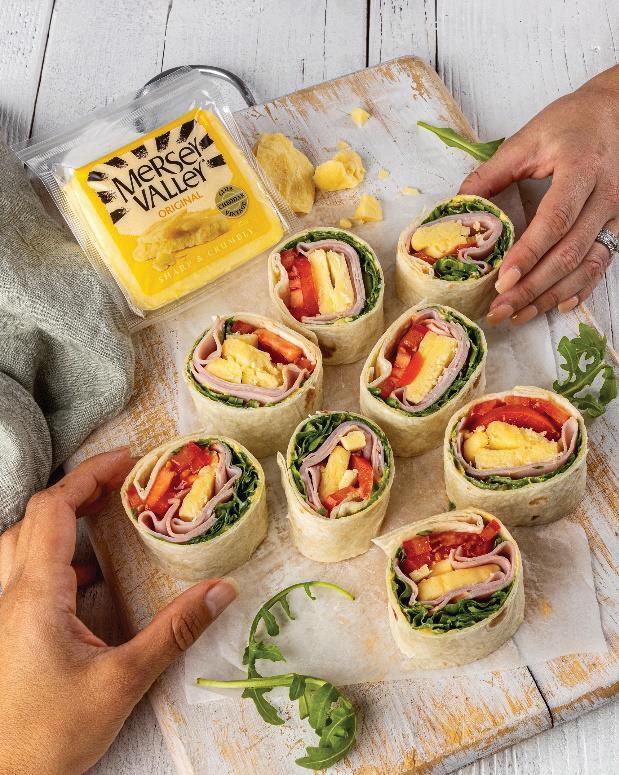


This range of cheese is one not to be missed, available at supermarkets nationwide. n





Karikaas has consistently produced great cheese, winning awards and gold and silver medals. Achieving this has taken a team effort, starting at the farm.

Julie Mehrtens of Oxford provides great milk from well-fed, happy cows. Diana Hawkins, the general manager, made the analogy that a silk purse cannot be made from a sow’s ear. Therefore great cheese cannot be made without great milk.
“We use Mehrtens milk to create our range of products. It takes everyone working together, having a passion for what they do, to make quality products every day they come to work,” said Hawkins.

Every cheese in Karikaas’ basic supermarket


range is a medal winner. Hawkins shared that the Gouda Vintage was a superb cheese, with a little going a long way in the mouth, boasting a full flavour and good aroma.




Hawkins advised that the Gouda Vintage was a great addition to a special dish or salad or perfect on its own with a glass of wine. The Young Gouda, Cumin, and Pepper were described as mild and creamy with a beautiful mouthfeel. Each with its fine flavour. Hawkins stated that each is lovely on its own, in a sandwich or for melting in a toastie or sauce.
Karikaas’ Maasdam cheese has the traditional eyes (holes), with a balanced fruity, nutty flavour and wonderful aroma. n


JUN 21

6th "JAPAN'S FOOD" EXPORT FAIR
June 21 - 23, 2023
Tokyo Big Sight, Japan
MIFB
Auckland Showgrounds

25 - 27 June

28-30 August 2023

SIAL GLOBAL FOOD INDUSTRY SUMMIT






Shenzhen Convention and Exhibition Centre
JUL 27
7th - 11th of October at the Messe Cologne, Germany OCT 7 PETER MITCHELLMemorial Golf Day & JUL


